The Basque Country( Baskonia or Escaudi) is the most mysterious region of Spain. Basques do not look like neighbors, neither culture, nor language, nor appearance.
Contents
- Basque Country on the map of Spain
- How to get to the Basque Country?
- What do you need to know about resting in the Basque Country?
- main resorts of the Basque Country
- Bilbao
- San Sebastian
- Vitoria-Gasteiz
- Attractions Basque Country
- Biosphere Reserve of Urdaibai
- Bermeo
- Mundaka
- San Juan de Gastelugache
- Caves Posalagua
- Tower Loizaga
- Forest Ohm
- Mountain Monte Gorbea
- Beaches of Costa Baska.
- . Kitchen of Basque Country. San Sebastian, Basque Country
- Video. National dances of the Basque Country
- Video. Songs of the Basque Country
Basque Country on the map of Spain
Baskonia is located in the northeast of Spain, on the shores of the Bay of Biscay( or the Cantabrian Sea).Historians still argue which language and cultural group the Basques belong to as an ethnos, because at the genetic level the Basques are very different from other representatives of Europe.
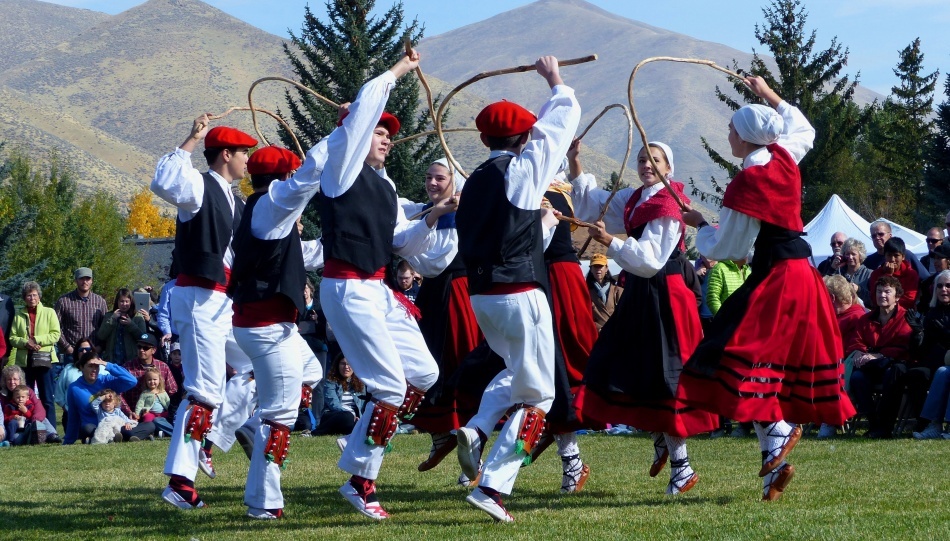
According to one version, the Basques came to the territory of modern Spain from the Caucasus, and retained their identity to our days, thanks to a solitary life in the mountain villages of the Basque Mountains. Many words in the Basque language have no related forms in any known language of the planet.
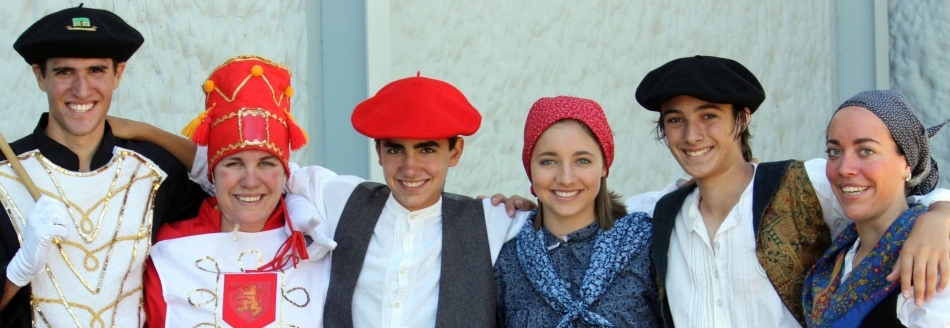 Basques
Basques In a word, Basques are a strange and mysterious tribe, their history is full of mysteries, and the culture is original and unlike any other people in the world. The largest cities in the region are Bilbao, San Sebastian and Vitoria-Gasteiz - the capital of the Basque country.
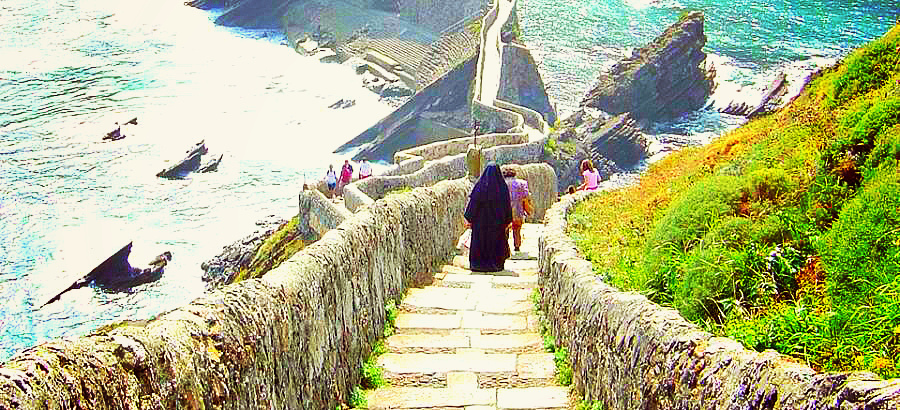
It should be noted that the historical borders of the Basque country extend beyond Spain and capture part of Aquitaine - the southern region of France, including the city of Biarritz. But this article will only deal with the Spanish Basques.
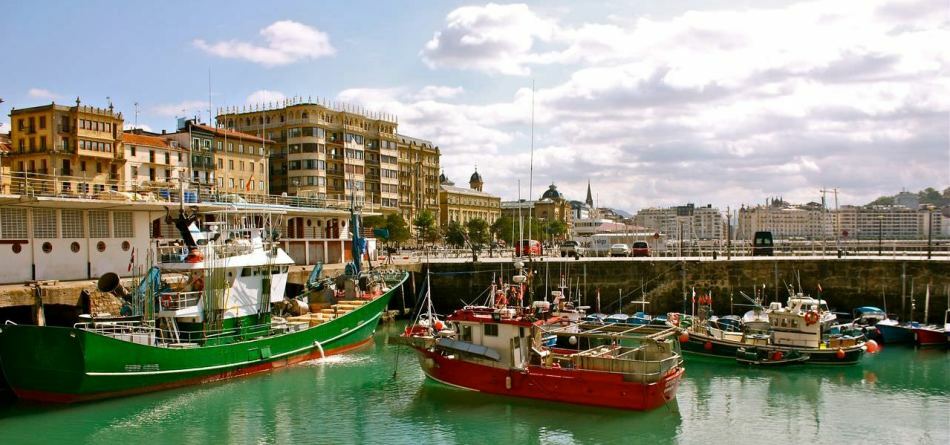
How to get to the Basque Country?
- There are no direct flights from Russia to the Basque Country. The easiest way to get to the plane from Russia is to fly to Madrid or Barcelona, then change to domestic flights or get on the high-speed train Renfe. There are internal airports in Bilbao, San Sebastian and Vitoria-Gasteiz.
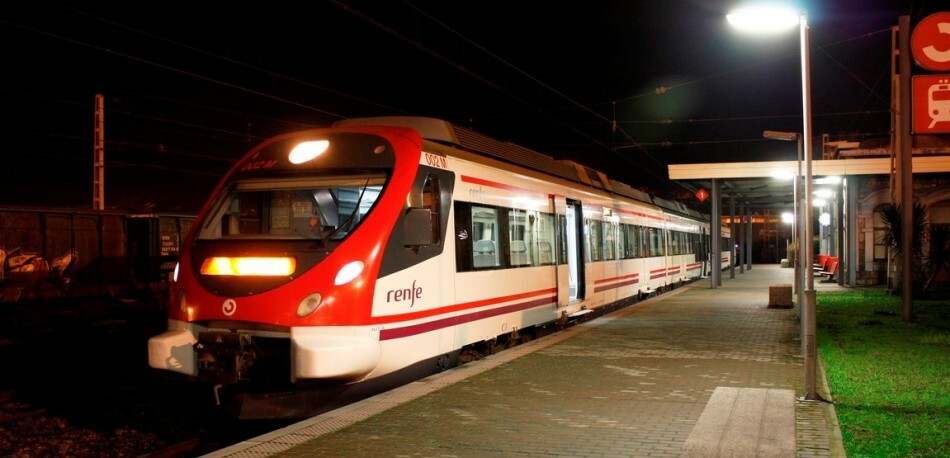
- From other European countries it's a little easier to get to Basque, as many European airlines fly directly to Bilbao, a full list of airlines can be seen here
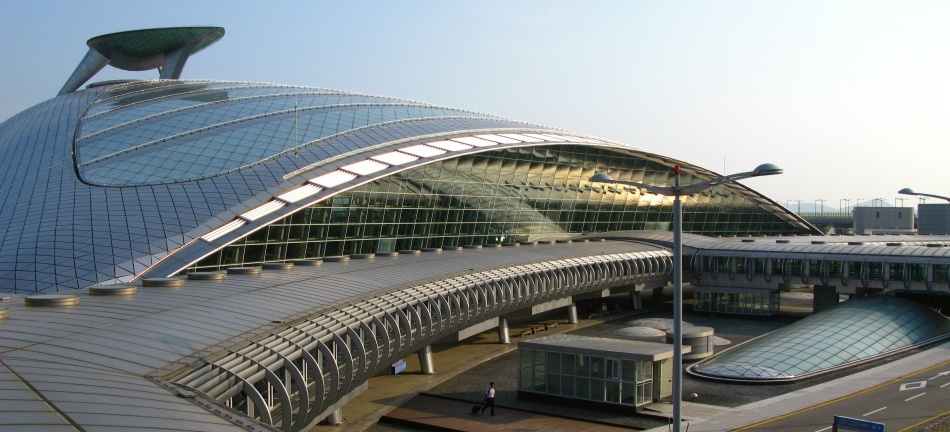 Bilbao Airport
Bilbao Airport - The second option is to get to the Basque Country - high-speed European highways. The road network is very well developed, you can reach the city of any region in the city, the toll highways connect Baskonia with all of Europe across the border with France in the northeast.
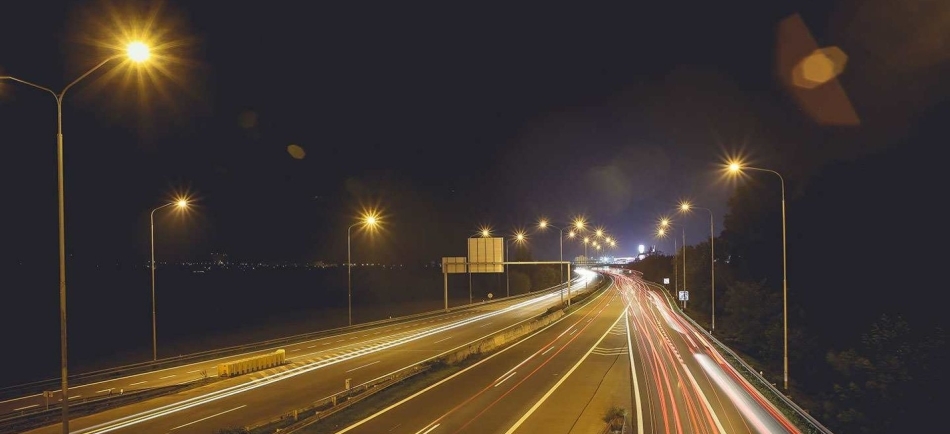
What do you need to know about resting in the Basque Country?
The climate of Baskonia differs from other resort regions of Spain in the same way as the Basques themselves. The summer temperature on the coast here rarely rises above + 25 degrees Celsius, and in Bilbao and in the inner mountain regions and even lower - in July the average temperature is around 20-21 degrees Celsius. But the warm waters of the Gulf Stream allow the sea to warm up more quickly than on the beaches of the Mediterranean.
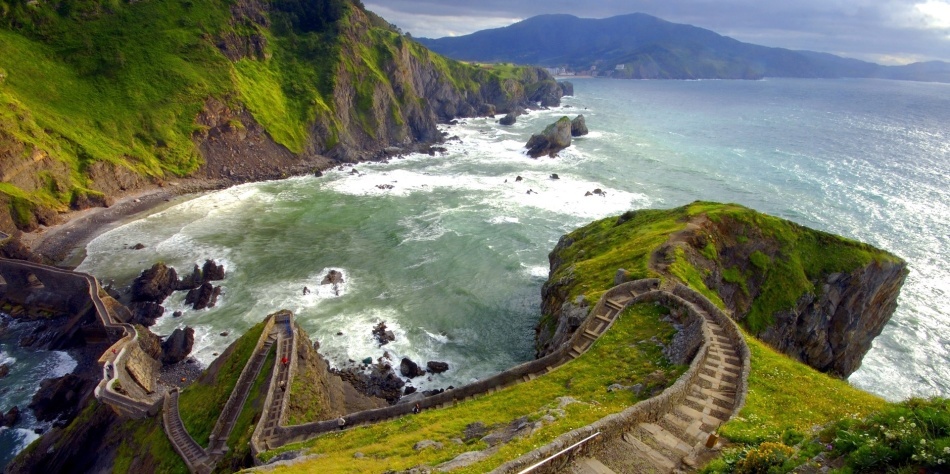
The Basque Country is a mountainous area. The beaches here are rugged with rocks, cozy sandy coves often alternate with steep high banks. There are more vegetation and greenery here than in other regions of continental Spain( Costa Brava, Costa Dorada, Costa Blanca, Costa del Sol), but less historical monuments of the era of the Romans, Arabs and early Middle Ages - the local landscape did not particularly attract conquerors and was not too suitable forthe construction of monumental buildings.
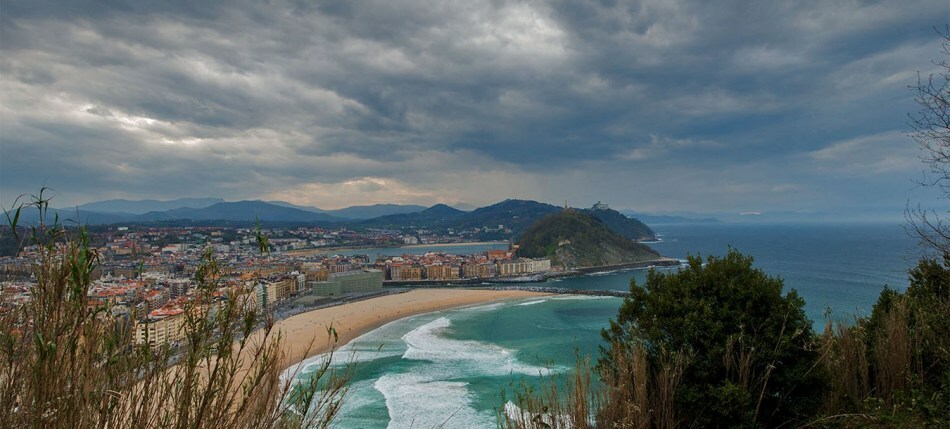
But this does not mean that the Basque country is not interesting. There is enough of its ancient buildings, beautiful architecture, amazing beauty of landscapes, excellent beaches and original cuisine.
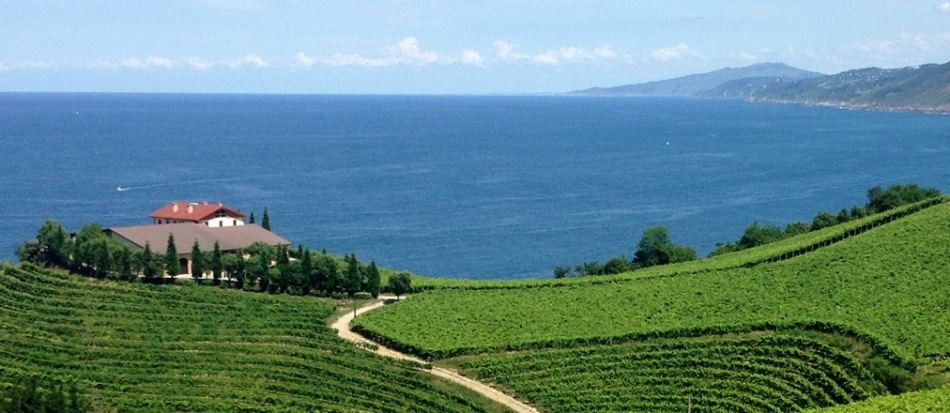
Another feature of Baskonia - this region is not too popular with tourists. There are fewer hotels here, newcomers often stay in rented apartments. In the metro and shops there is less tourist advertising, on the streets you rarely see excursion bureaus.
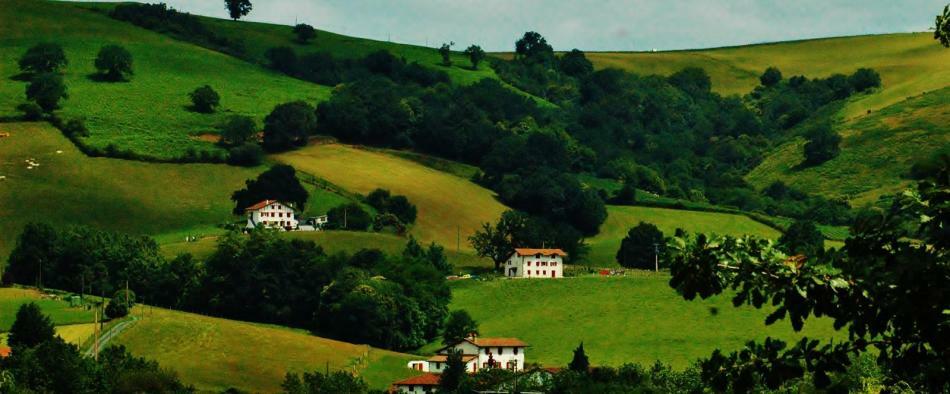
Travel agencies in Russia often did not even hear about the Basque Country. Therefore, the trip will most likely have to be organized independently, and preparation will take more time than usual. But all your troubles will be more than paid off by the impressions of rest in this amazing place.

The main resorts of the Basque Country
The best beaches of the Basque Country are located on the Costa Vasca in the Gipuzkoa area near San Sebastian. It is the coast of the Atlantic Ocean, where waves are more frequent and higher than in the Mediterranean. It does not get too hot, cloudy days happen even in July and August, so the Basque Country is ideal for those who are contraindicated or simply do not like too active sun.

Bilbao
Bilbao is a completely atypical city for Spain. Its architecture is often more like Amsterdam or Stockholm, but not a hot Spanish city. The typical weather in Bilbao also absolutely does not fit the templates, to which we are accustomed at the word "Spain".
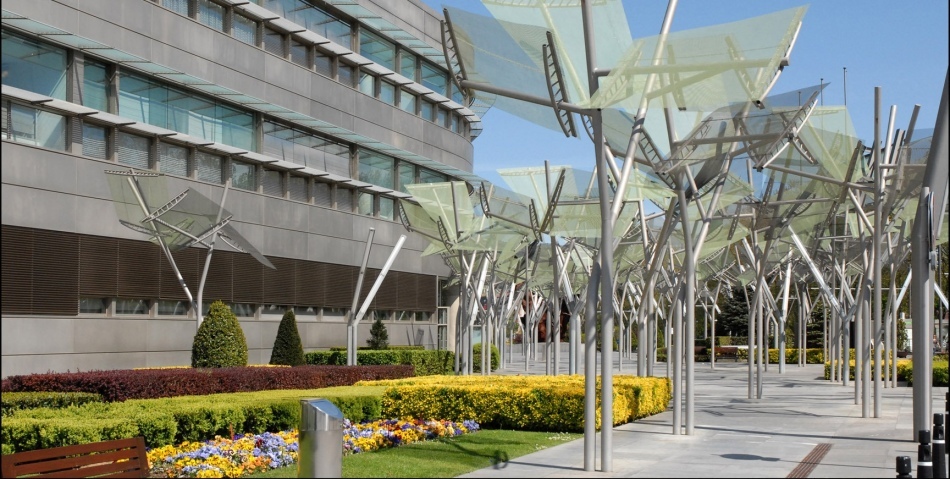
In Bilbao, it's almost always cloudy and cloudy, often the embankments are clouded with fog, and even in the middle of summer there are days when instead of a bright beach dress you have to pull on a jacket and waterproof shoes.
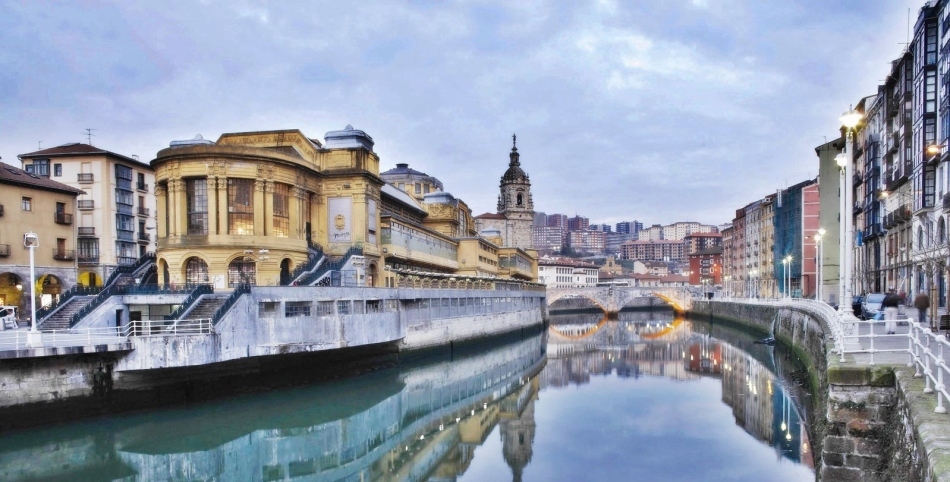
But frequent and abundant rains make the landscapes of the Basque country amazingly bright: juicy lawns and forests can not be compared to sun-burned palm trees and lawns of Andalusia or Valencia.

Guggenheim Museum
The Guggenheim Museum Bilbao is one of the branches of the Museum of Modern Art of the famous New York collector and philanthropist Solomon Guggenheim.
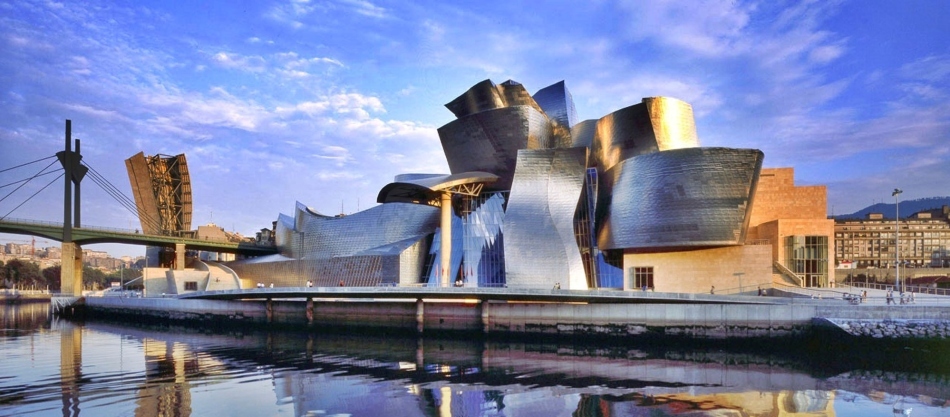 Guggenheim Museum, Bilbao
Guggenheim Museum, Bilbao The building has a very unusual appearance, its exposition is equally unusual, which includes works by modern avant-gardists: Andy Warhol, Iva Klein, Kuning and others.
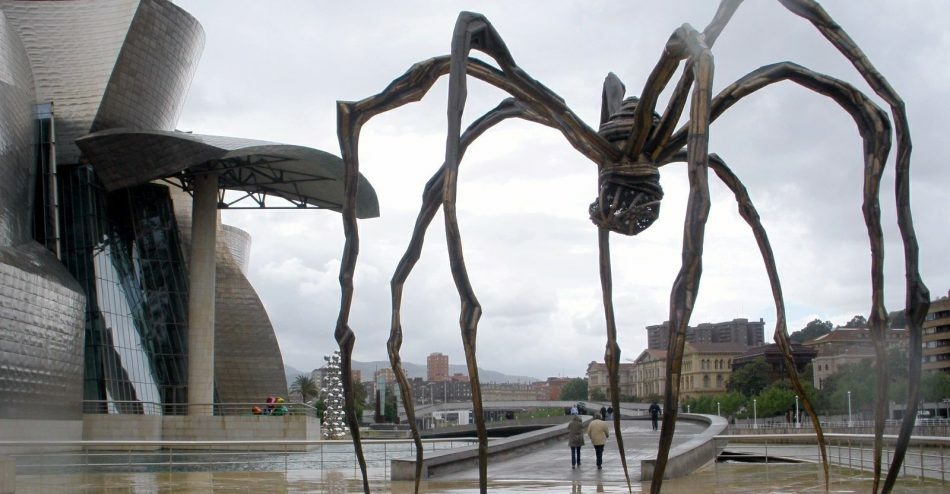 Guggenheim Museum, Bilbao
Guggenheim Museum, Bilbao Also interesting is the space around the museum. On one side of it on the waterfront is the famous sculpture of a giant spider, on the other - a huge floral puppy of the work of Jeff Koons, near which tourists like to be photographed.
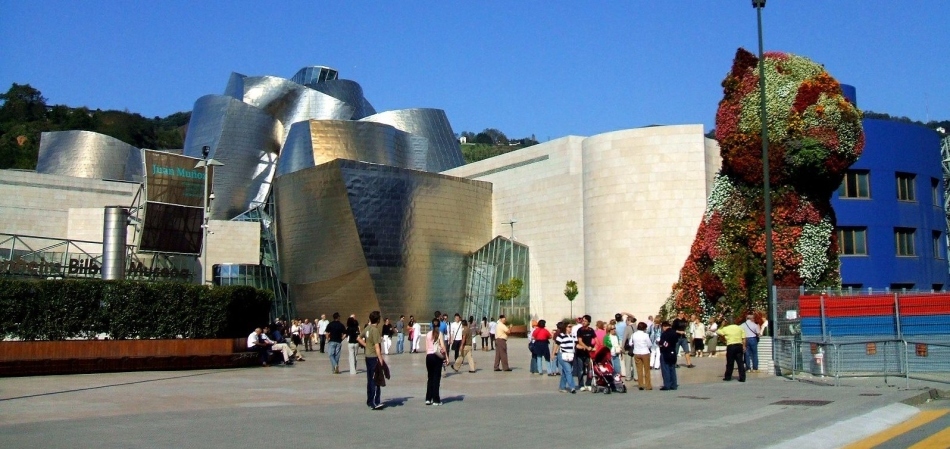 Statue of a puppy near the Guggenheim Museum. Bilbao
Statue of a puppy near the Guggenheim Museum. Bilbao The natural continuation of the museum complex is the bridge of Puente de la Salve, built by Daniel Buren within the framework of the world project "red arches".
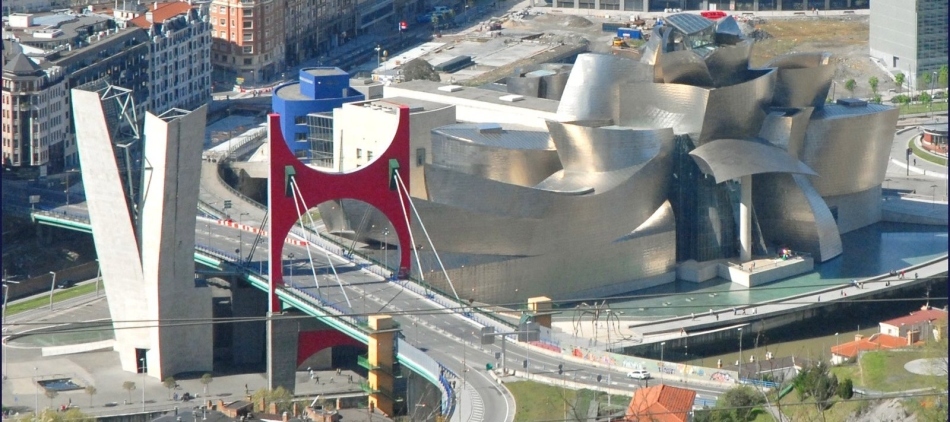 Bridge Puente de la Salve, Bilbao
Bridge Puente de la Salve, Bilbao Metro Fosteros
Metro Bilbao( here it is affectionately called "Fosterolis" - by the name of the architect-creator) is another design object of national scale along with the building of the Guggenheim Museum. The Norman Foster himself worked on the subway project - the most famous English architect and honorary member of the Academy of Arts of many countries of the world, including Russia. Therefore, the metro station is an indispensable must see for any tourist in Bilbao.
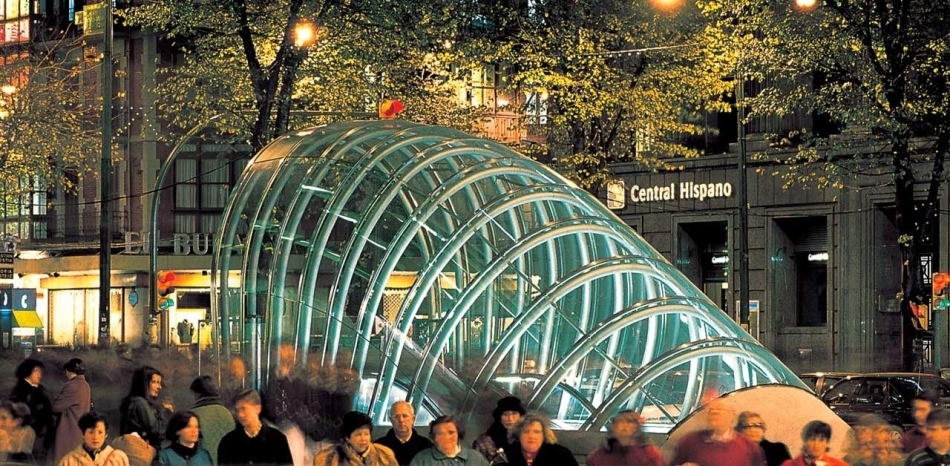 Metro Fosteros, Bilbao
Metro Fosteros, Bilbao Multicultural center Alondiga
La Alondiga is a true architectural masterpiece of the famous French industrial designer Philippe Starck. Earlier in this building of the beginning of the XX century there was a wine warehouse, but now only the outer walls remain of it, behind the facade of which there is an ultra-modern structure of glass and concrete. Here is located an entertainment center with cinemas, restaurants, a swimming pool, a financial center, a huge library and other entertainments.
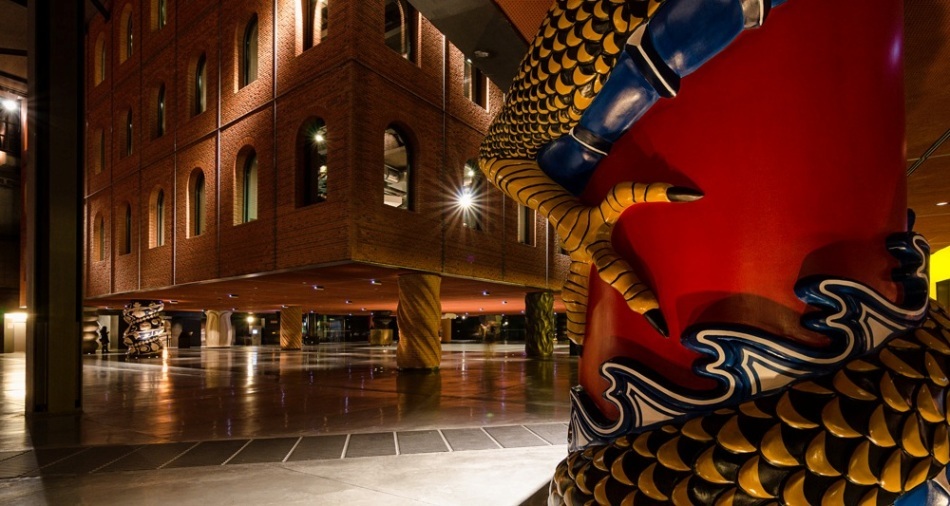 Multicultural Center Alondiga, Bilbao
Multicultural Center Alondiga, Bilbao Ministry of Health of Bizkaia
The building of the Ministry of Health of Bizkaia( the district of Basconia, whose capital is Bilbao) resembles anything, just not a boring state institution. Inside, of course, you can not get, but even for the sake of an examination outside it is worth to find this masterpiece in the street Alameda Recalde, 39. Against the backdrop of the building are amazing avant-garde photos.
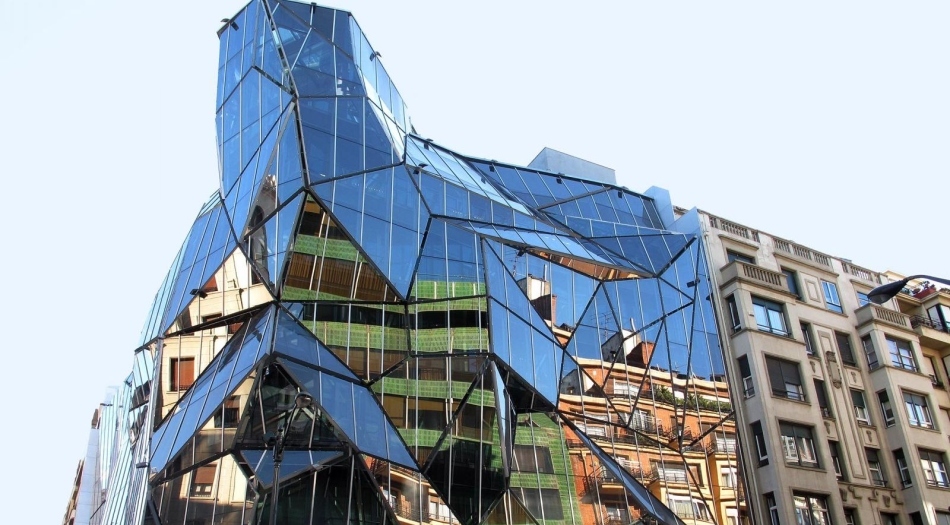 The Ministry of Health of Bizkaia, Bilbao
The Ministry of Health of Bizkaia, Bilbao The Subi-Suri Bridge
A very unusual bridge that once again confirms the glory of Bilbao as a city of avant-garde architecture. The span of the bridge does not have supports and is kept exclusively on the original suspension structure. The pedestrian zone of the bridge is paved with glass transparent tiles, which looks very stylish, but it is very impractical for the city budget( the tile too often has to be changed).The bridge is very popular with local lovers at night.
 Subi-Suri Bridge, Bilbao
Subi-Suri Bridge, Bilbao Fine Arts Museum
The museum's extensive collection includes over 7,000 exhibits. The earliest are carved wood sculptures from the 12th century. In the collection of paintings there are canvases by Van Gogh, Francisco Goya, El Greco, Van Dyck and many others, including the autumn of interesting and original Basque painters. Also in the museum are very interesting modern exhibitions.
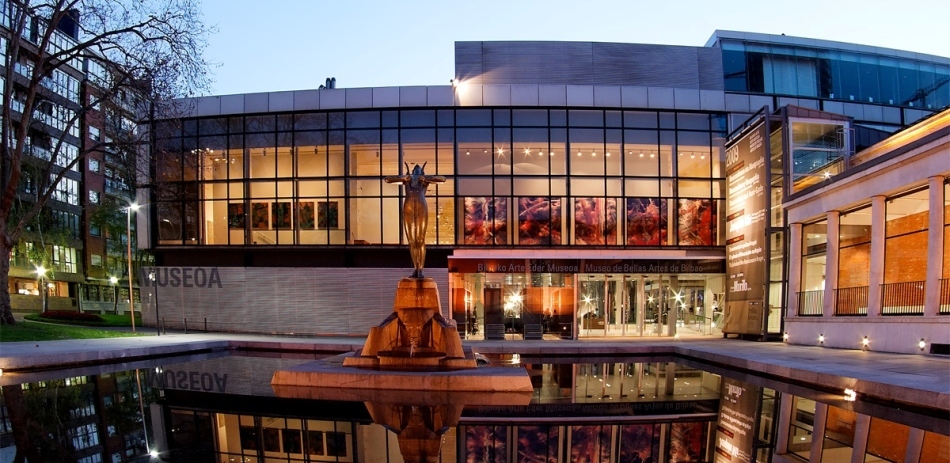 Museo de Bellas Artes de Bilbao
Museo de Bellas Artes de Bilbao District of Ensanche
Ensanche is a district of the beginning of the 19th century, in which the Concordia train station and the Palace of the Deputation deserve attention. The main street of the district is Gran Vía Avenue, which is home to many branded stores of famous clothing brands.
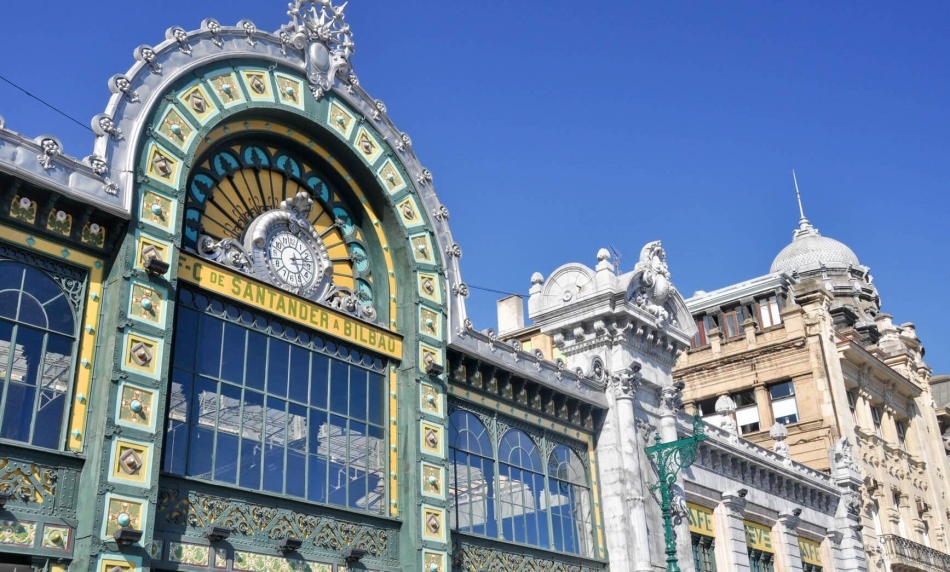 Station Concordia, Bilbao
Station Concordia, Bilbao Old town of Casco Viejo
Casco Viejo - the oldest district of Bilbao - consists of only 7 streets because before the beginning of the XIX century Bilbao was an inconspicuous fishing village. There are a lot of beggars, private shops and nice little cafes where excellent pinchos( local snacks) are served with a glass of chakoli( local wine).In Bilbao there is a funny word "chiquitear", which in translation means "wander around the local pubs and try chakoli with pinchos".
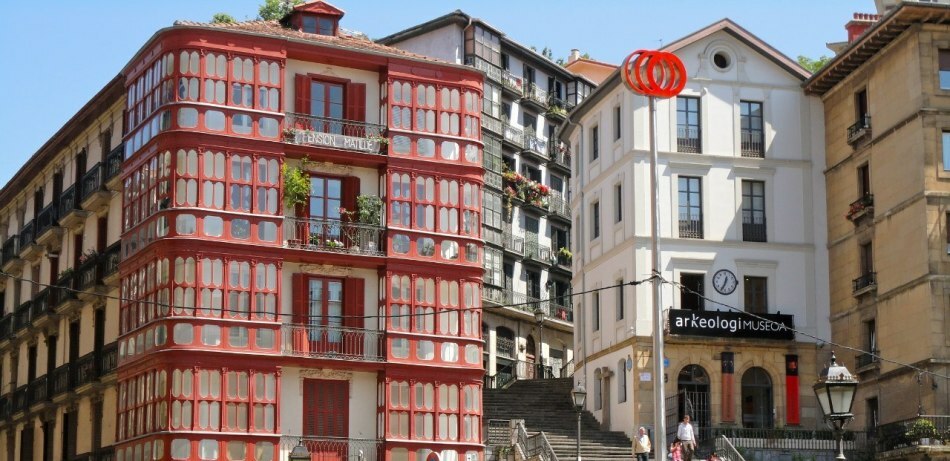 The Old City of Casco Viejo, Bilbao
The Old City of Casco Viejo, Bilbao La Ribera Market
The indoor food market of La Ribera is Europe's largest covered market. Here you can try all the local dishes and enjoy the special atmosphere of small-town trade: a variety of smells, noisy local merchants, power customers and curious tourists. It is especially interesting to stroll to the market in the morning, when all the housewives of the city flock here to buy the freshest products for lunch.
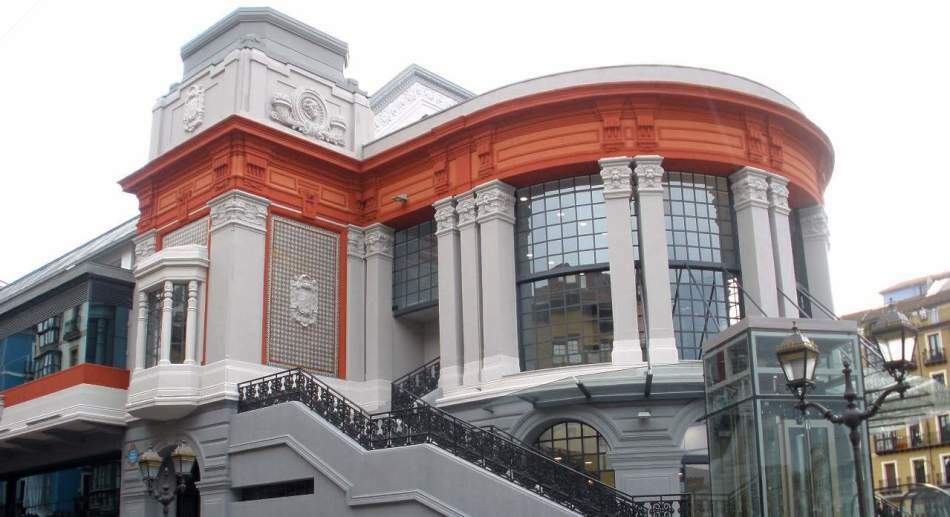 Market La Ribera, Bilbao
Market La Ribera, Bilbao Calzada de Malone
Calzadas de Malone is a staircase of 312 steps that leads to the basilica of the Virgin Begonias on the top of the hill of Etchedorria. It is not a ladder, but a whole street, constantly leading steeply upwards. Along it there are pretty old houses, and with every turn before your eyes an ever more amazing view of the city opens. The basilica of the Virgin Begonia is dedicated to the Virgin of Our Lady - the ancient patroness of the Basque country.
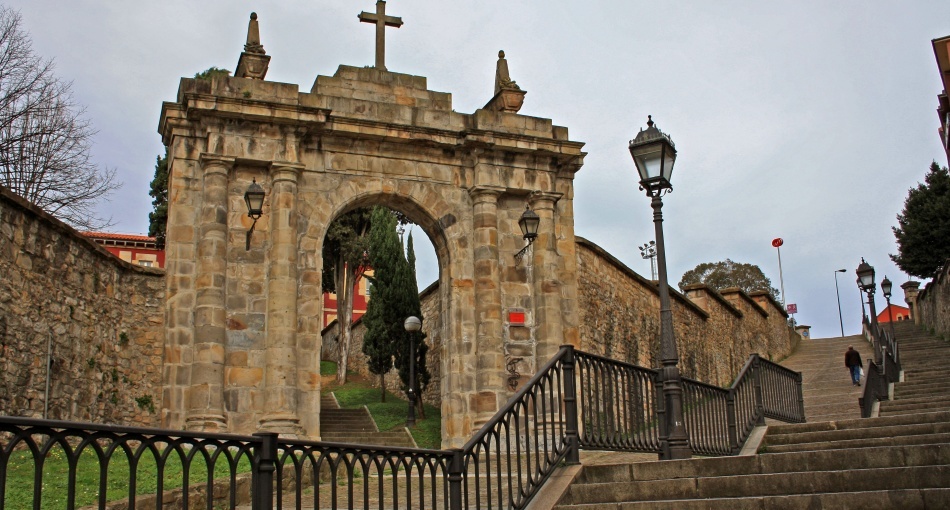 Calzadas de Malone, Bilbao
Calzadas de Malone, Bilbao Gothic cathedral of Santiago
The Cathedral of St. Jacob is perhaps the only building preserved in the city since the XIII century. Actually, at that time the city was not yet in sight, and the cathedral was built as part of the popular pilgrimage route of the medieval Spain of Santiago de Compostela.
 Gothic cathedral of Santiago, Bilbao
Gothic cathedral of Santiago, Bilbao Euskaldun Palace
Euskaldun Palace( Palace of Congresses and Music) is a new theater building in Bilbao, fully equipped for the most sophisticated technical productions of modern productions. There are also meetings of the local parliament. The palace was twice recognized as the best work of architecture - in 2001 it became the most interesting architectural solution in Spain, and in 2003 the international association declared it the best parliamentary building in the world. On the third floor of the building is the best restaurant in the city, awarded the Michelin stars.
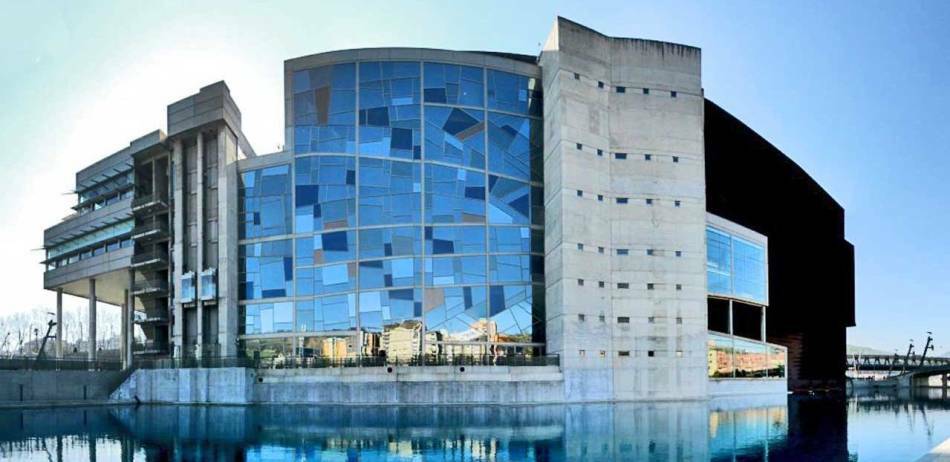 The Palace of Euskaldun, Bilbao
The Palace of Euskaldun, Bilbao The Maritime Museum of Bilbao
This is a very interesting museum for inspection, located in the old port docks of the Euskalduna district. The exposition includes seagoing ships, characteristic for different epochs of the Basque history. All ships are available for inspection. Also in the museum you can see ancient protection letters, trade agreements, coins and sea charts. You can try yourself in the role of a sailor, learn how to set sail, knit a sea knot and climb the rope ladder.
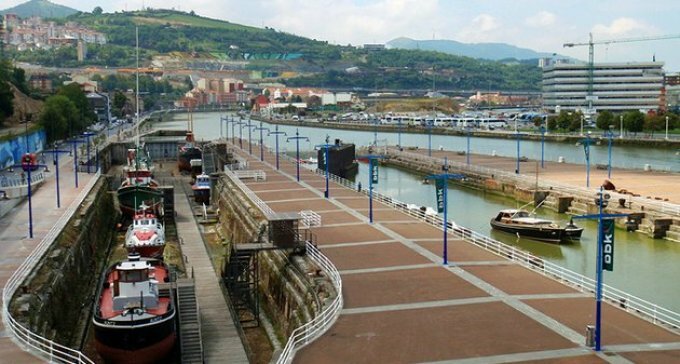 Bilbao Maritime Museum
Bilbao Maritime Museum Beaches of Bilbao
In the suburb of Bilbao, Getxo, there are two popular beaches of Las Arenas and Ereaga. The center of Bilbao with suburbs connects the metro, so that, despite some distance, it will not be difficult to get to the beaches. The best beach in Bilbao is in the suburb of Plence( 40 minutes by metro) - it is believed that this area is very popular with wealthy townspeople because of its excellent fish restaurants.
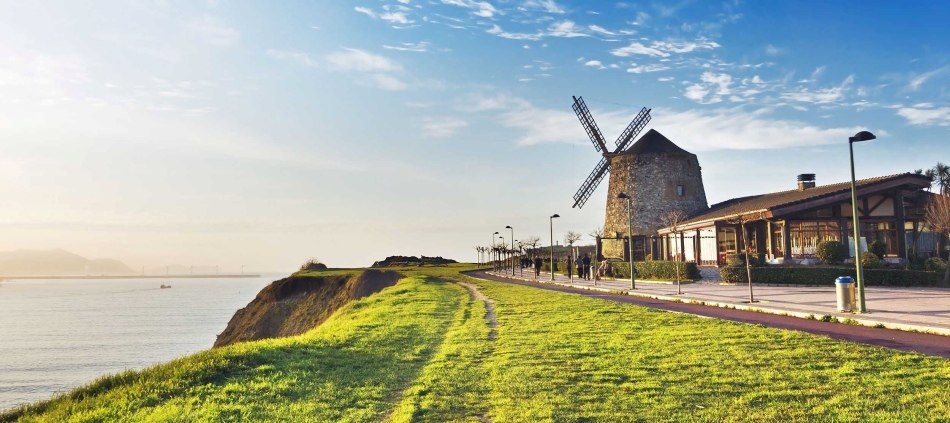 Geco, suburb of Bilbao
Geco, suburb of Bilbao San Sebastian
San Sebastian is a fairly old settlement, the first buildings date back to the XII century. In the Middle Ages, it was a notable trading port, but the city suffered very badly during the war with Napoleon: there were practically no pre-war buildings left, all buildings were wiped off the face of the earth, so in the XIX century it was in utter decay.
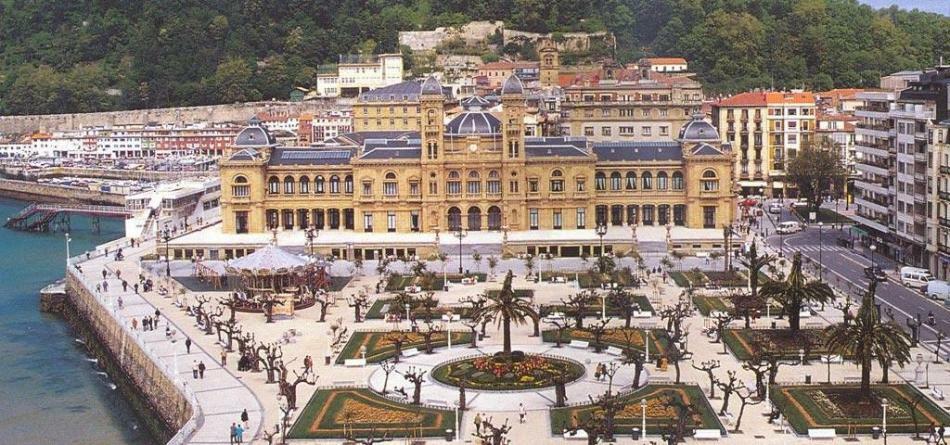
The revival of San Sebastian occurred at the beginning of the 20th century, when the Queen of Spain, Isabella decided to set up her country residence here. Due to this, San Sebastian became very fashionable as a place of rest in aristocratic circles, and gradually regained its former glory.
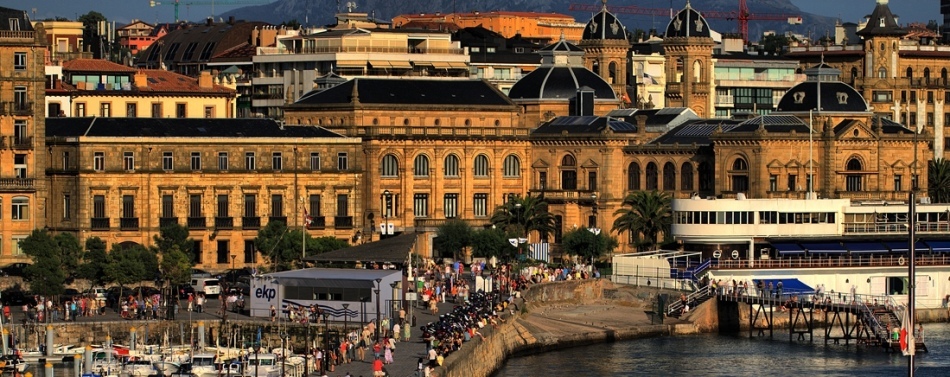
In the entire architecture of San Sebastian, analogies with Paris are traced, as in the construction of the city the architects responded above all to the tastes of the Spanish Crown and the court nobility. San Sebastian is a surprisingly beautiful city, which, unfortunately, is still underestimated by tourists.
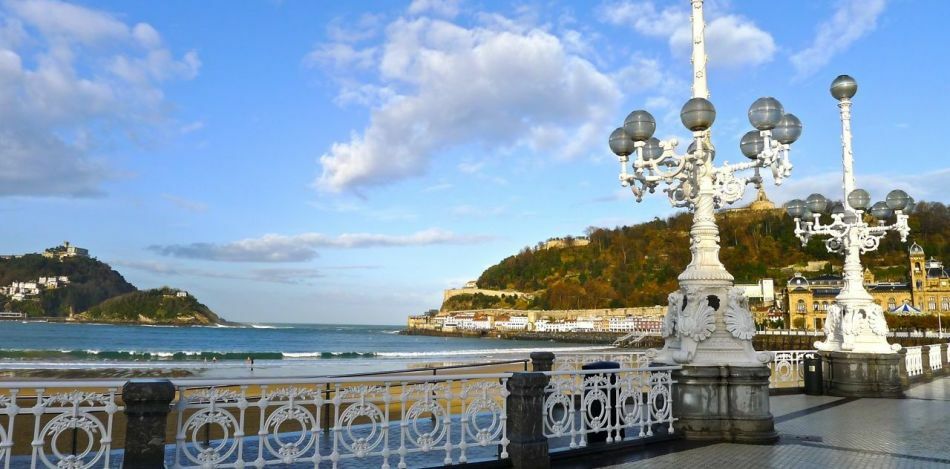
Mount Monte Urgul
Monte-Urgull is remarkable for its ruined castle Castillo de Santa Cruz( locals call it La Mota), which is crowned with a statue of Christ. Currently, within the walls of the castle is the historic museum of San Sebastian, and the castle itself is surrounded by a small park with walking alleys and observation platforms.
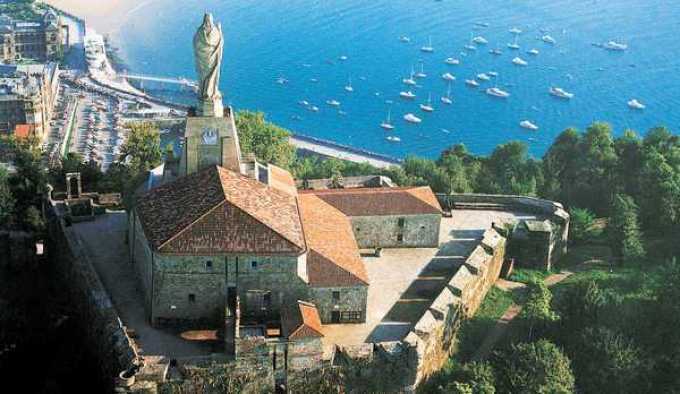 Mount Monte Urgul, San Sebastian
Mount Monte Urgul, San Sebastian Street August 31
31 Agosto is the only surviving street in the war with Napoleon in all of San Sebastian. In memory of those events on the street, a parade of local residents is held annually in historical costumes and the reconstruction of those distant events.
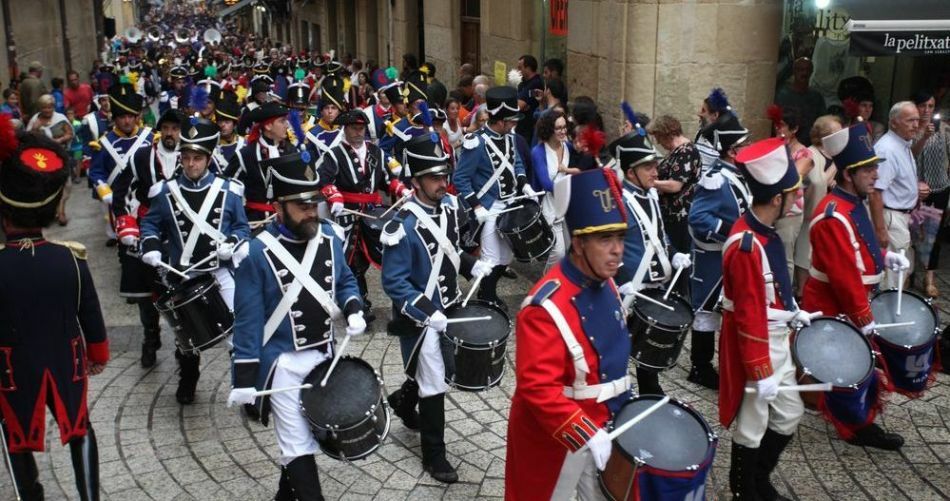 Street August 31, San Sebastian
Street August 31, San Sebastian San Telmo Monastery
The Museum of San Telmo( Museo de San Telmo) is located in the former 15th-century monastery. The exposition includes works of art, as well as archaeological finds related to the history of the region.
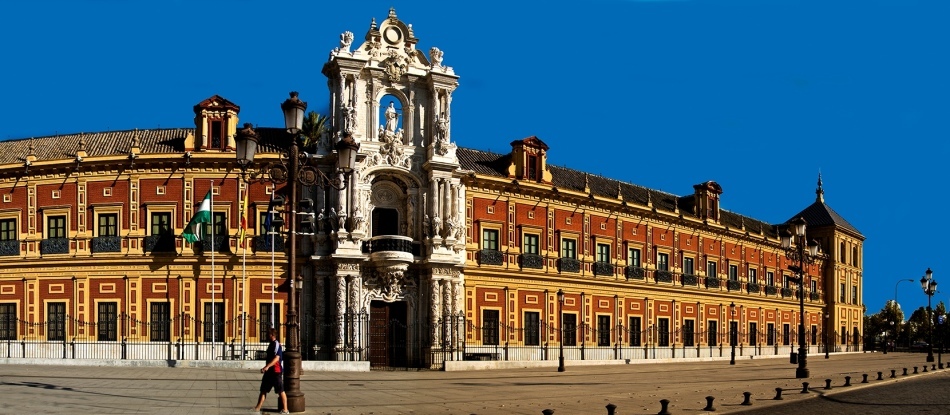 Monastery of San Telmo, San Sebastian
Monastery of San Telmo, San Sebastian Santa Maria del Coro
Church of Santa Maria del Coro( ) dates back to the XVIII century, built in the center of the old town in the place of the same ruined medievalchurches.
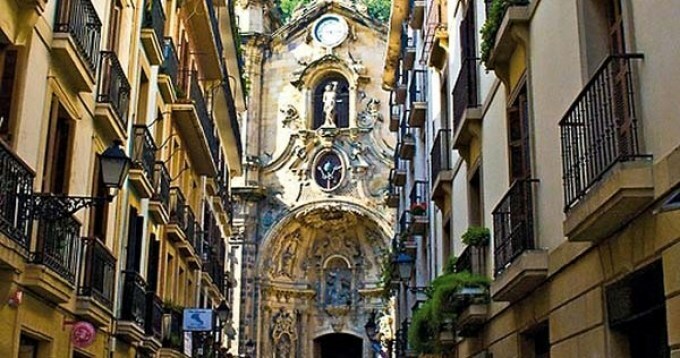 Church of Santa Maria delCoro, San Sebastian
Church of Santa Maria delCoro, San Sebastian Parte Vieja
Parte Vieja is the historic quarter of San Sebastián, a classic 18th-19th century building with many cozy cafes and small shops. In the center of the quarter is the main square of the city - Constitution Square( Plaza de la Constitución) , where you can see the building of the former town hall.
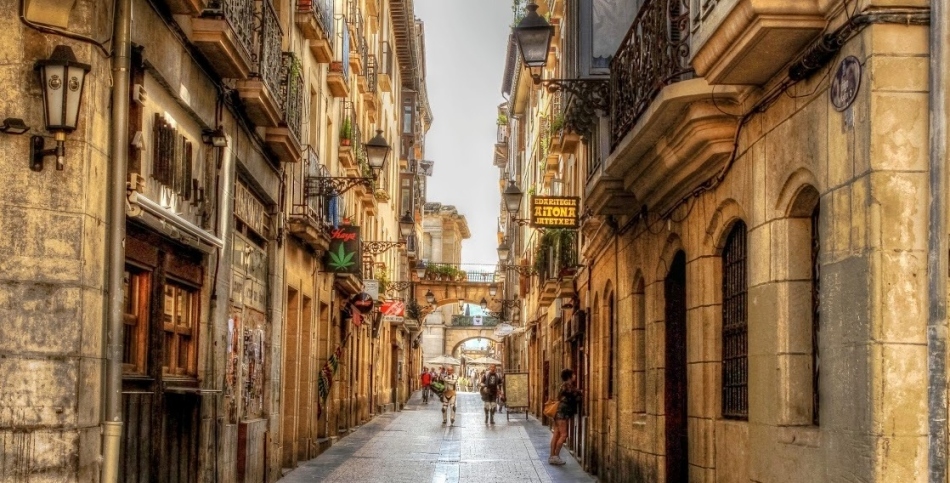 Parte Vieja, San Sebastian
Parte Vieja, San Sebastian There is one interesting detail: the municipality of the city bought out the balconies of the surrounding houses from the residents whose windows face the square;in the days of city holidays, when colorful parades and performances are held on the square, balconies are sold to all comers as the best spectator places on the show.
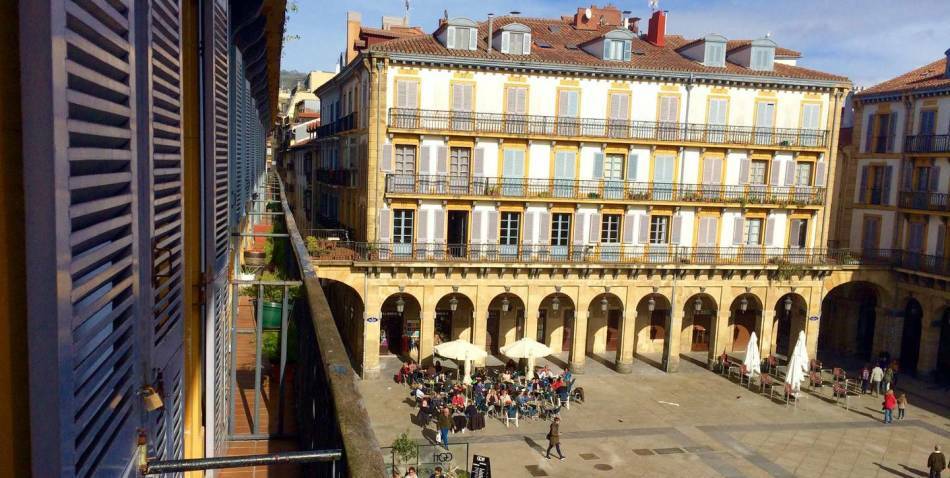 Constitution Square, San Sebastian
Constitution Square, San Sebastian La Concha Bay
La Concha Beach( Playa de la Concha) is considered one of the best beaches in Europe. It is to him that San Sebastian owes its rebirth. This is a picturesque bay, forming a regular circle in the center of which rises the green island of Santa Clara. Queen Isabella of Spain, appreciating the beauty of the landscape, at the beginning of the XX century ordered to build here the royal baths. La Concha has long been considered a beach for the elect.
 The Bay of Concha, San Sebastian
The Bay of Concha, San Sebastian The Cathedral of the Good Shepherd
The Catedral del Buen Pastor The is the main cathedral of San Sebastian, the largest church in Basque Country. It houses several local church relics, and regular worship services are held, for which it is worth to descend for the sake of beautiful organ music.
 The Good Shepherd Cathedral, San Sebastian
The Good Shepherd Cathedral, San Sebastian Miramar Palace
Palacio de Miramar Palace is a copy of a typical English castle built for Queen Mary Cristina as a summer residence. The palace is open to tourists.
 Miramar Palace, San Sebastian
Miramar Palace, San Sebastian Cristina-Enea Park
Cristina Enea Park is one of the most beautiful and large parks in Spain. In the XIX century, one of the local nobles gave the city their land with the only condition - they should be divided into a park, and nothing more.
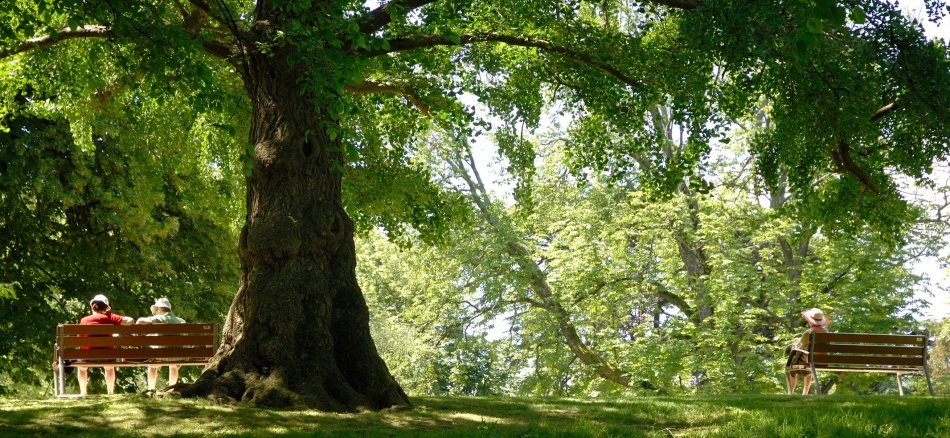 Cristina-Enea Park, San Sebastian
Cristina-Enea Park, San Sebastian Maria-Cristina Bridge
The Maria-Cristina Bridge( Puente de Maria Cristina) is a 19th-century building in which the French architecture of the time can be clearly imitated. Obelisks along the edges of the bridge resemble sculptures on the Alexander III bridge in Paris, named after one of the Russian emperors.
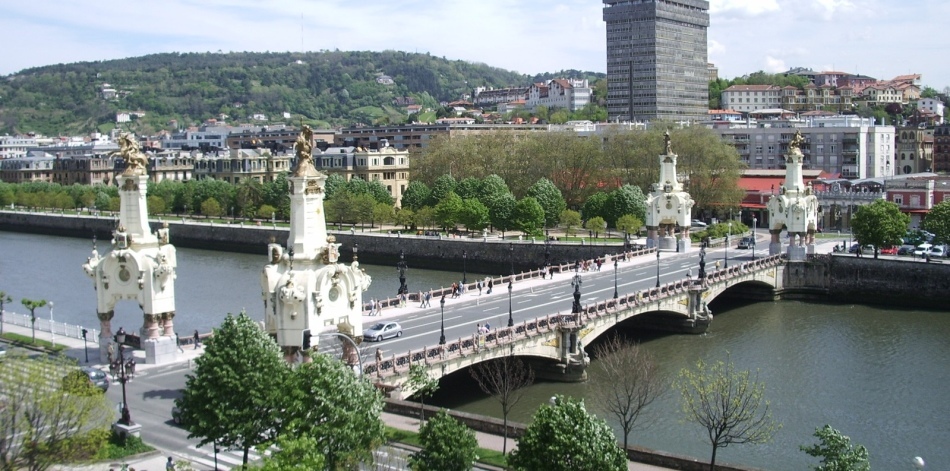 Maria-Christina Bridge, San Sebastian
Maria-Christina Bridge, San Sebastian Vitoria-Gasteiz
Vitoria-Gasteiz is the capital of Basque Country. It is located not on the coast, but in the depths of the mainland. Vitoria is the Spanish official name of the city, and the Basques call their capital Gasteiz. The city dates back to the 12th century, although according to some sources, the first settlement here was founded in 585 AD.

The main attractions of Vitoria-Gastez are located in the old town, and most of them are objects of religious significance:
- Medieval Cathedral of Vitoria
Church of St. Peter the Apostle( Iglesia de San Pedro Apostol) XIV century - Church of St. Archangel Michael( Iglesiade San Miguel Arcangel) XIV century
- Church of St. Basilica of San Prudencio de Armentia XII century
- Church of the Holy Martyr of Vincent( Iglesia de San Vicente Martyr) XV-XVI centuries
- Convento de Santa Cruz of the XVI century
- Monastery of Saint Anthony( Convento de San Antonio) XVII century
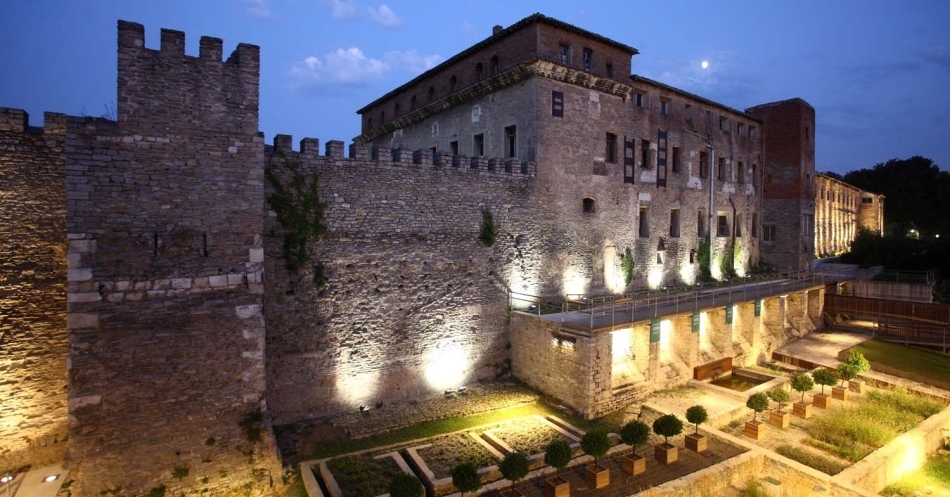
Other attractions include the following:
- House del Cordon( Casa del Cordon) - a house of a merchant of the XV century, a period of the former residence of the Spanish kings in the Basque country, and now a museum exposition telling the story of Basque's life and history
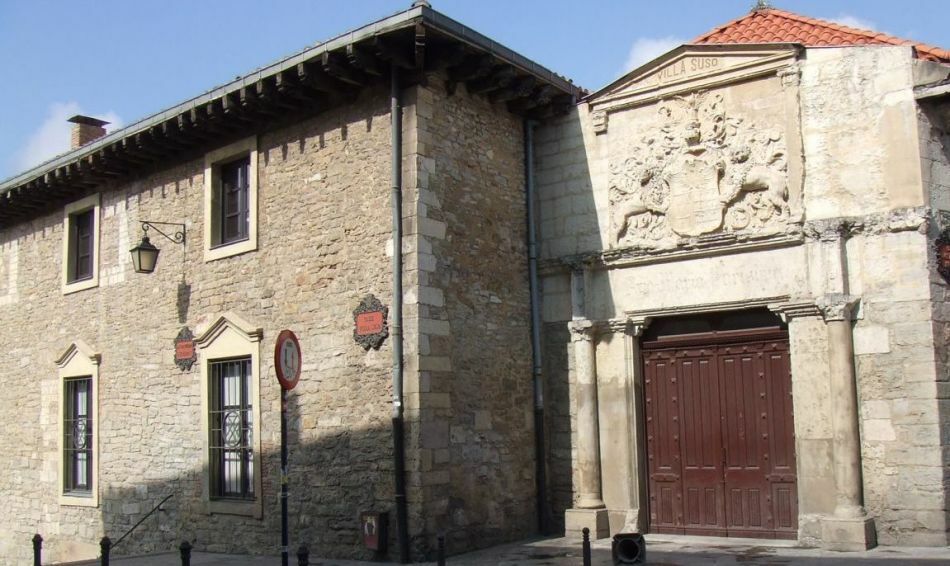 House del Cordon, Vitoria Gasteiz
House del Cordon, Vitoria Gasteiz - Palacio de Ajuria-Enea - Basque Parliament building
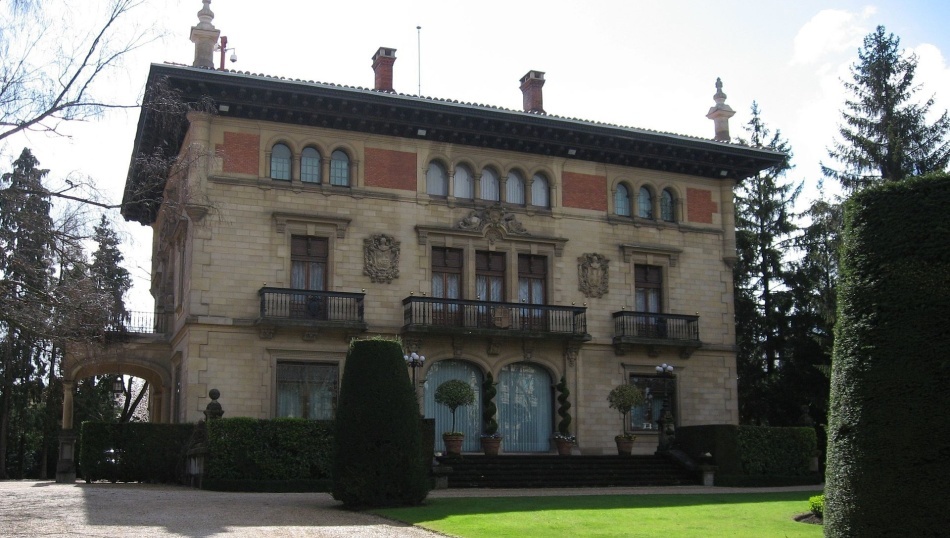 Akhuria Enea Palace, Vitoria Gasteiz
Akhuria Enea Palace, Vitoria Gasteiz - The Basque Museum of Contemporary Art( Museo Vasco de Arte Contemporaneo) is an exhibition of works by contemporary artists of Basconia and recognized(Picasso, Dali, Miro, Perez), as well as the educational center, library and city archive
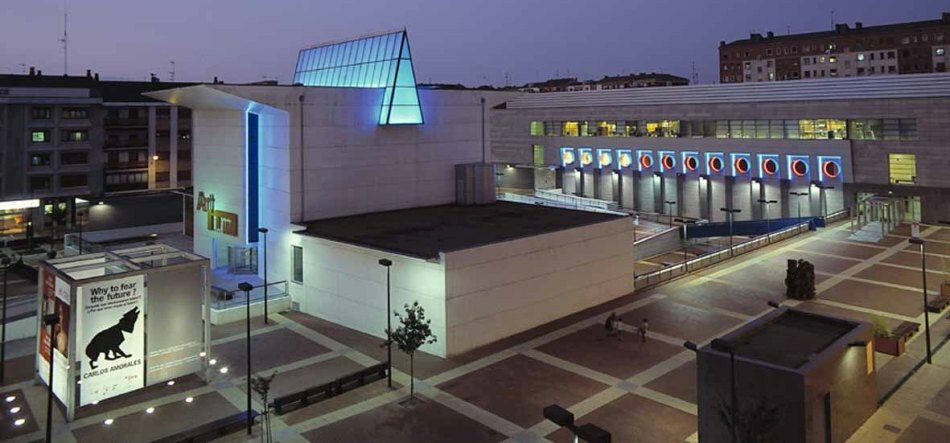 Basque Museum of Modern Art, Vitoria Gasteiz
Basque Museum of Modern Art, Vitoria Gasteiz - The Plaza de la Virgen Blanca - the main square of Vitoria-Gasteiz, onwhich is the Monument of the Battle of Vitoria during the War of Independence in 1813
 The Virgin Mary Blanca Square, Vitoria Gasteiz
The Virgin Mary Blanca Square, Vitoria Gasteiz Sights Basque Country
Biosphere Reserve Urdaibai
Urdaibai Nature Reserve is located between San Sebastian and Bilbao. On the territory of Urdaibai is Guernica, which was described in the eponymous painting by the famous Pablo Picasso - a city completely destroyed by the fascists and became a national symbol of the Basques. Castle Butron will take us to the romantic XIX century. The chapel of San Juan de Gastelugache, which is led by a staircase of 231 steps, will recall the biblical stories( according to legend, John the Baptist visited here).The forest of Om will plunge into the space of land art, a fashionable trend in art that turns natural objects into a fairy-tale world.
 Nature Reserve Urdaibai, Basque Country
Nature Reserve Urdaibai, Basque Country Bermeo
Bermeo is one of the main ports of Baskonia, a typical fishing town with a distinctive architecture and atmosphere. Here they catch the famous white tuna, which is found only on the Atlantic coast. The date of foundation of Bermeo is attributed to the time of Roman rule, although local legends say that it was founded immediately after the Flood. In Bermeo, you should definitely go to see the real Basque city, beautifully preserved its antiquities and untouched by the destructive wars of Napoleon and Franco.
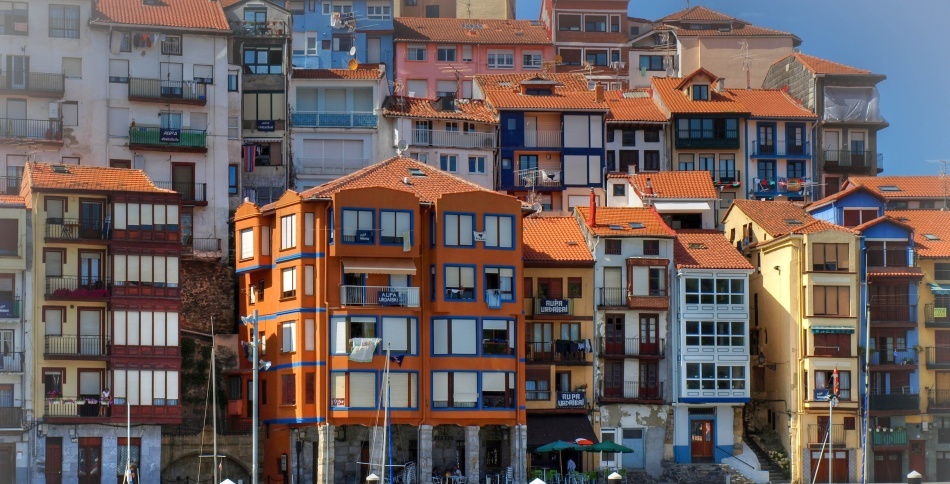 Bermeo, Basque Country
Bermeo, Basque Country Mundaka
Mundaka is another charming town on the Costa Baska. In translation from the old Scottish language Mundaka means "pure water".According to legend, the city was founded by the Scots, who fled from the persecution of the English crown. Although there is evidence of an earlier presence of man in these places: in the cave of Santimamiñe, rock carvings dating back to the Paleolithic times are found, and the remains of the Roman road indicate the presence of the Romans.
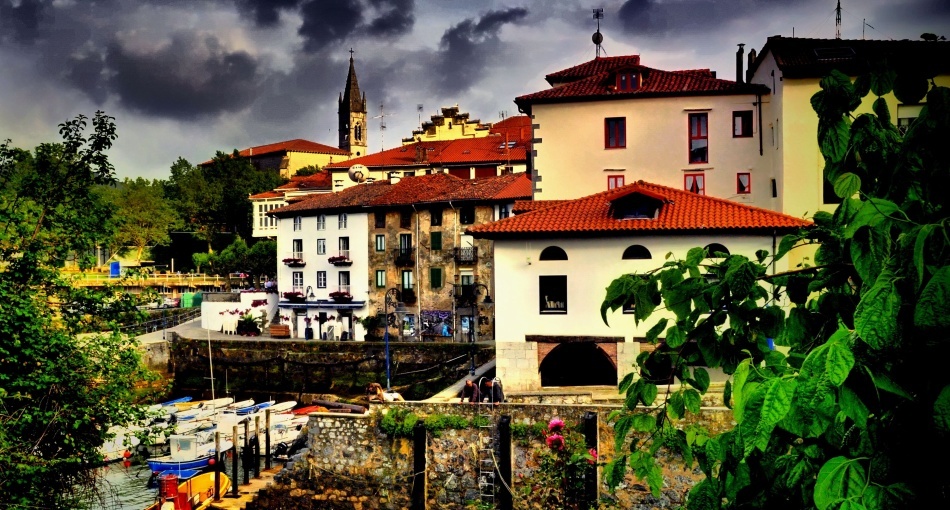 Mundaka, Basque Country
Mundaka, Basque Country Also locals believe that there were quite a few Vikings in Mundaka, as the locals stand out against the background of the other Basques with their growth, blue eyes and blond hair. Mundaka is very popular with surfers for the waves characteristic only for this resort.
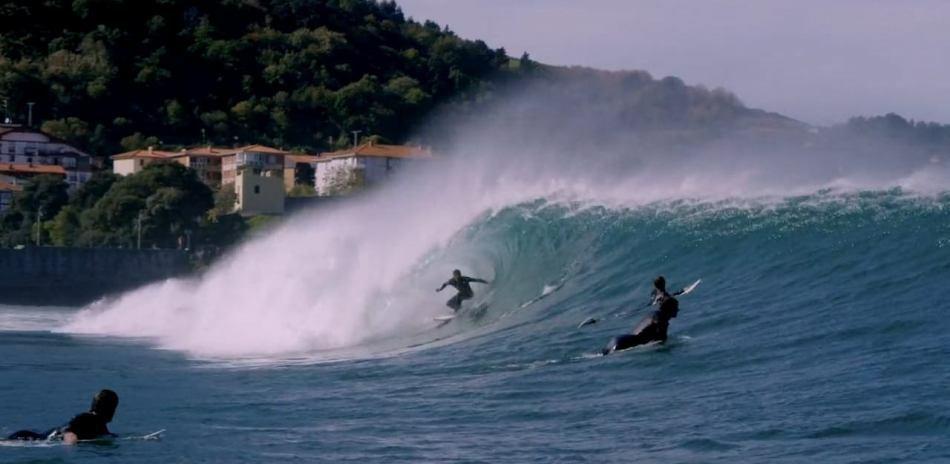 Surfing in Mundaka, Basque Country
Surfing in Mundaka, Basque Country San Juan de Gastelugache
San Juan de Gaztelugatxe is an ancient Christian chapel, to which is led an unusual stone bridge-staircase of 241 steps. The place here is truly fantastic, thanks to the surrounding scenery and exciting history.
 San Juan de Gastelugache, Basque Country
San Juan de Gastelugache, Basque Country The Knights Templar was located here, the island was raided by one of the most famous pirates in the history of Frances Drake, it was attacked by the kings of Castile and the knights of La Rochelle, here languished in the cellars and martyred the victims of the Inquisitionin the Middle Ages. On one of the steps of the staircase there is an ancient footprint, which, according to legend, belongs to John the Baptist himself( San Juan).
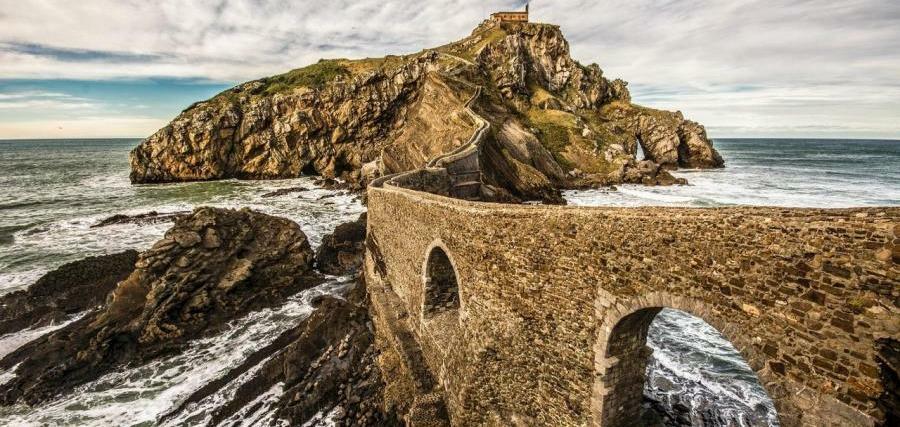 San Juan de Gastelugache, Basque Country
San Juan de Gastelugache, Basque Country Caves of Posalagua
According to the Spaniards, the Cave of Posalagua( La Cueva de Pozalagua) is the most beautiful corner of Spain in 2013( according to the results of the annual survey of the national publication Guía Repsol).This is a unique natural karst formation, dotted with many stalactites of unusual shape and beauty. Currently, under the arches of the cave, concerts are often given, as the acoustics of the cave make the sounds of music truly fascinating.
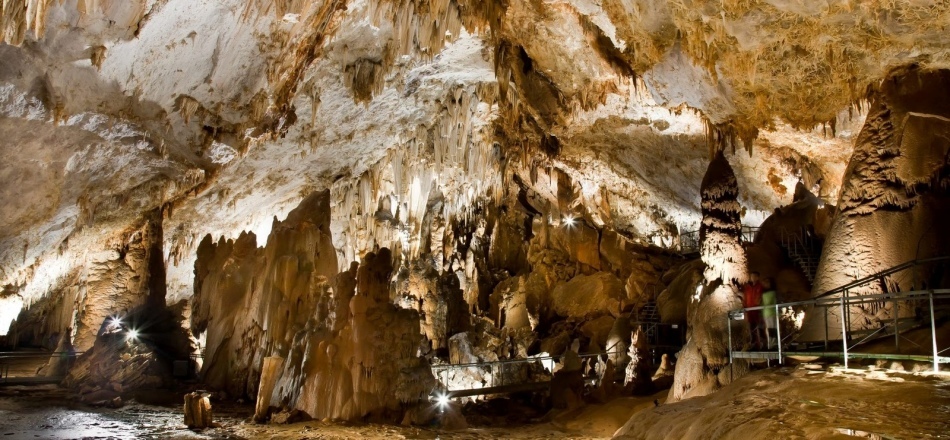 The Caves of Posalagua, Basque Country
The Caves of Posalagua, Basque Country The Loisaga Tower
Loisaga is a medieval tower in the village of Consechuelo de Galdames, named for the first owner. The place is notable for the fact that now there is a private museum of old cars Rolls-Royce. This is truly a luxurious collection, which, in addition to cars, contains antiques, dressing carriages and crews from different eras. The museum is awarded the highest professional awards of the world.
 Automobile Museum with Loisaga Tower, Basque Country
Automobile Museum with Loisaga Tower, Basque Country Forest of Oma
The forest of Oma( Pintado de Oma) is a fairy tale created by the hands of Man. Augustin Ibarolla, a local sculptor and artist, spent several years here in the 1980s, creating works in the style of art-land. The forest has many mysteries, as some works can be seen in their entirety, only standing at a certain angle. For the observant visitors, the artist placed indexes on the ground, along which you can find those most cherished points of view.
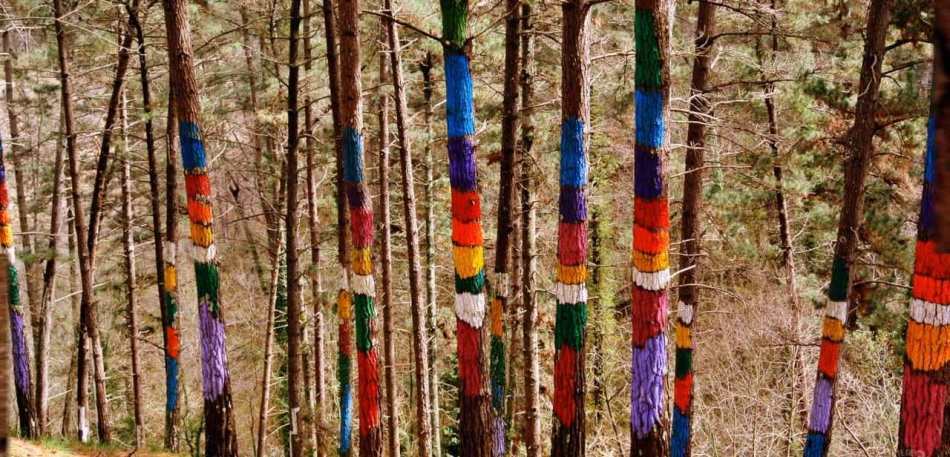 Forest of Ohm, Basque Country, Spain
Forest of Ohm, Basque Country, Spain Cave of Santimaminier
Santimamiñe Cave is the most important archeological find of Basconia, in which the earliest rock carvings in the interval from the Middle Paleolithic to the Iron Age were discovered. Most of the images date back to the late Paleolithic, the era of the Mousterian culture, characteristic of the primitive hunters of preglacial Europe.
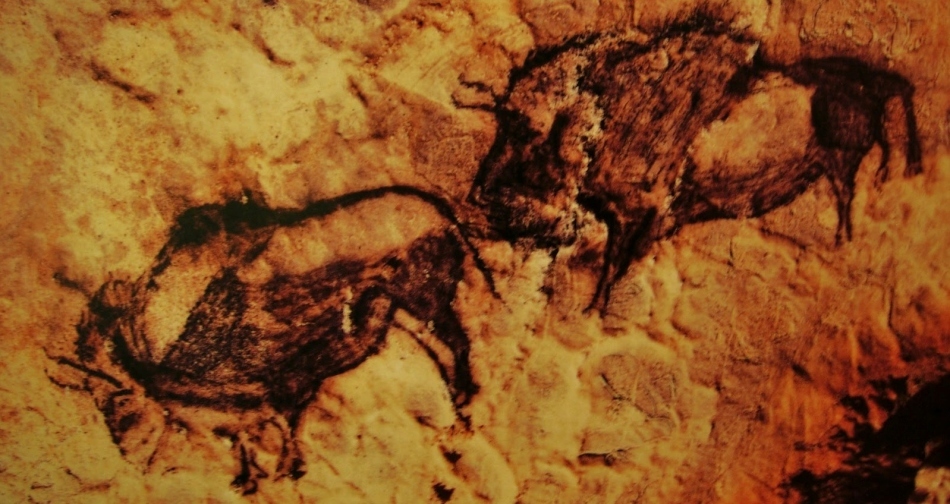 Cave Santimaminier, Basque Country
Cave Santimaminier, Basque Country Monte Gorbea Mountain
The Monte Gorbea Natural Park( Monte Gorbea) has historically existed for more than 100 million years. This is a truly mystical place where the crowns of ancient trees are fantastically interwoven, the old trunks are overgrown with moss and lichen, and the forest lowlands often envelop a dense fog, giving the forest a mystical and frightening appearance.
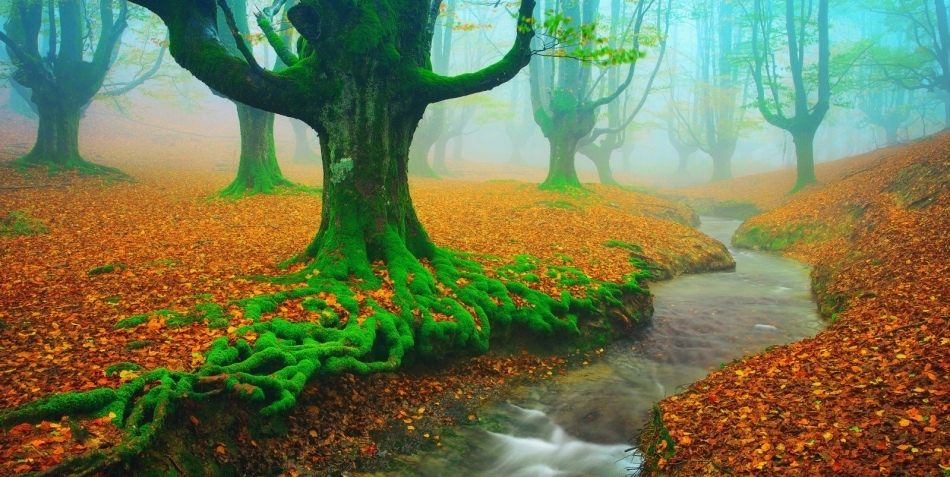 Nature reserve of Gorbea, Basque Country
Nature reserve of Gorbea, Basque Country There are many rare animals and plants here, since 1994 the forest has been given the official status of a protected area protected by law. On the territory of the natural park for those wishing to spend night and day safaris.
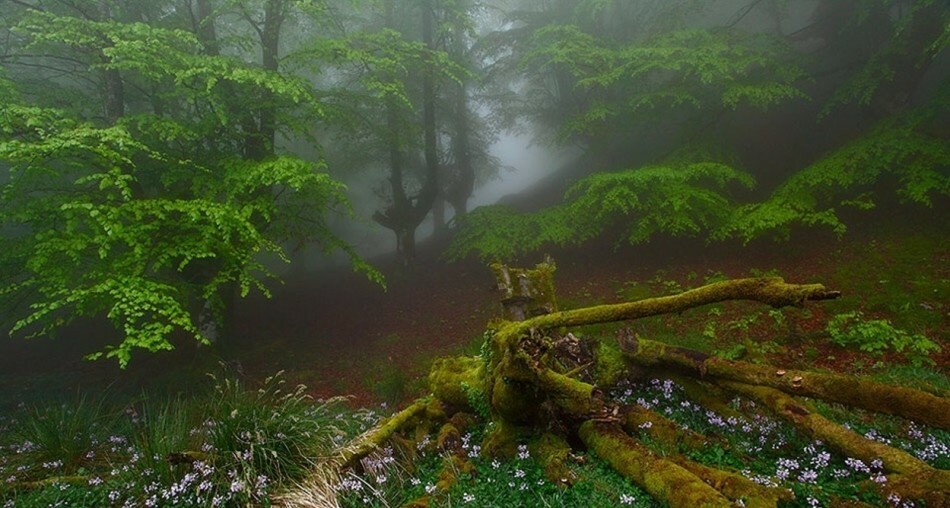 Gorbea Nature Reserve, Basque Country
Gorbea Nature Reserve, Basque Country Beaches Costa Baska
- La Concha beach( Playa de la Concha) is one of the best in Europe;a wide band of sand and a gentle entrance;closed bay, where there are no waves;equipped with everything necessary;in the royal baths a modern thalassotherapy center operates;is located within San Sebastian, therefore all urban infrastructure is within walking distance.
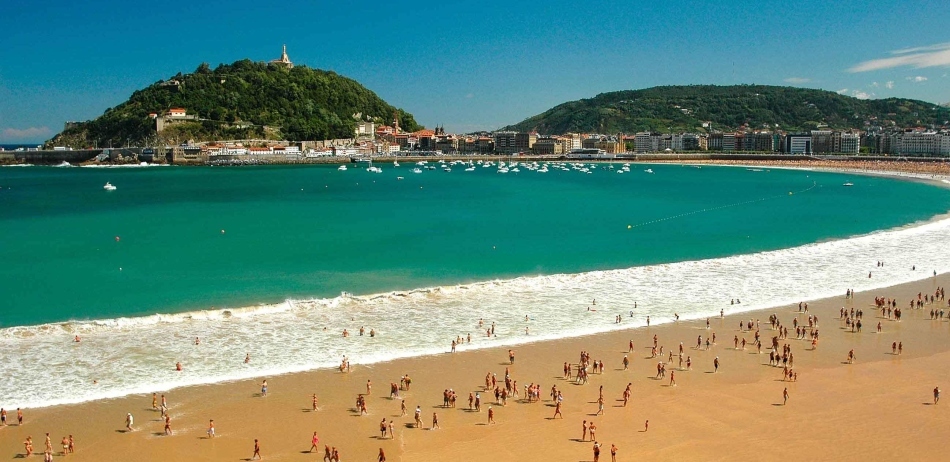 La Concha beach( Playa de la Concha)
La Concha beach( Playa de la Concha) - La Zurriola beach - located on the outskirts of San Sebastian, some distance from the city;many surfers, there is a surf school;Suitable only for experienced swimmers because of strong waves;well-developed infrastructure( cafes, beach equipment, shops, etc.);recently popular with nudists, which is not suitable for some tourists
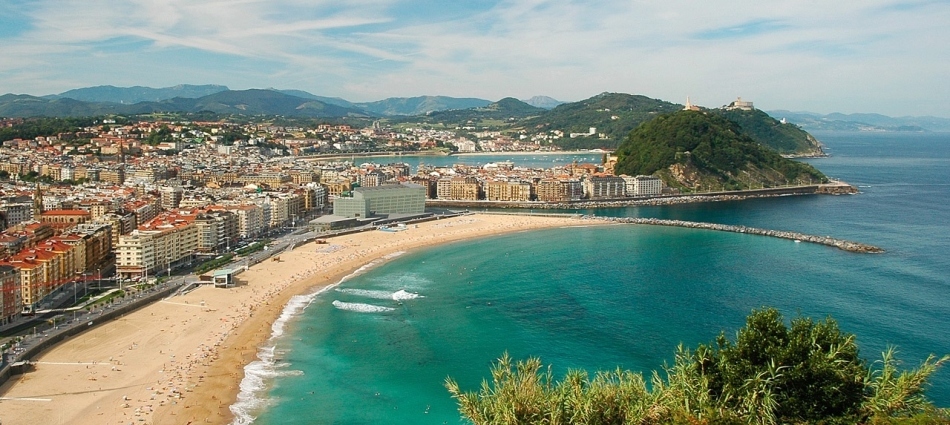 La Zurriola Beach
La Zurriola Beach - Ondaretta beach( Playa Ondaretta) - located in San Sebastian, well suited for families;sandy beach, gently sloping entrance, beach volleyball courts, wooden walkways, cafe
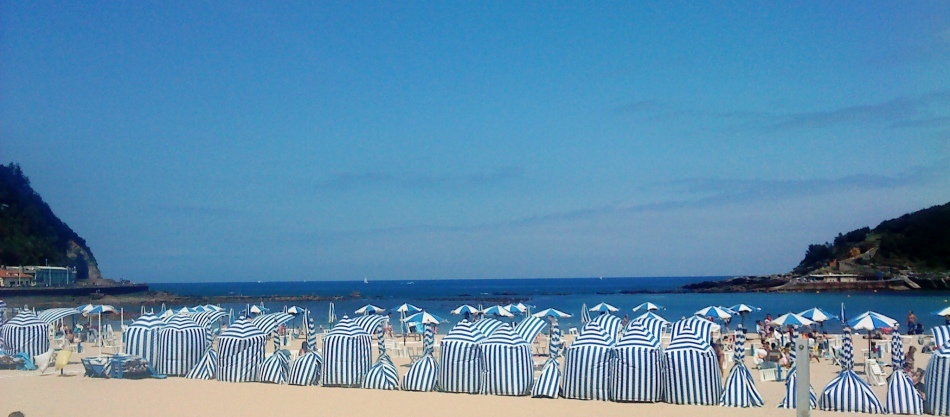 Ondaretta beach( Playa Ondaretta)
Ondaretta beach( Playa Ondaretta) - Beaches of Sukarrieta and Laga - located in Mundaka, very popular with surfers because of the unique "left"wave, which occurs only here. Equipped with all necessary, nearby are several hotels, camping, cafes and restaurants
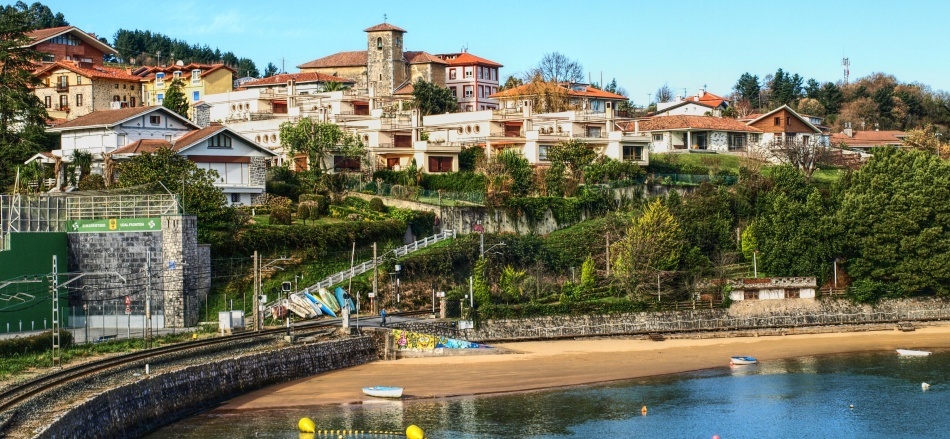 Sukarrieta beach
Sukarrieta beach - Ondarribia beach is a beach located in the same town;well suited for leisurely family holidays, equipped with everything necessary;The city has a pleasant walk - the old medieval center, the Gothic churches, the castle of Charles V, and the port embankments with colorful houses
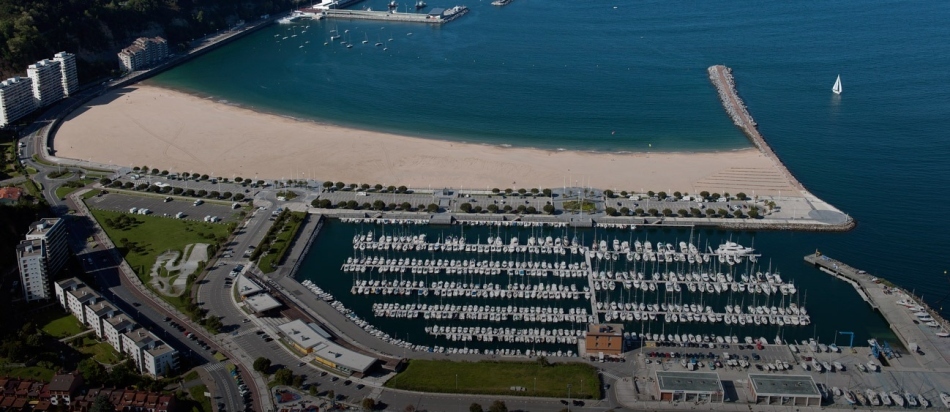 are very beautiful. Hondarribia Beach
are very beautiful. Hondarribia Beach - Zarautz Beach is another favorite surfer beach that is not suitable forof ordinary beach rest
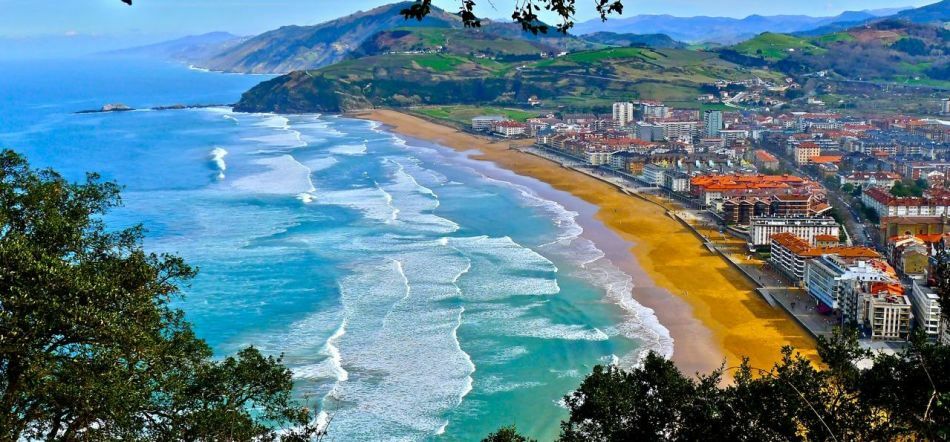 Beach of Zarautz
Beach of Zarautz - Ria de Gernika - a cozy bay with wide sandy beaches, located in the town of Guernica
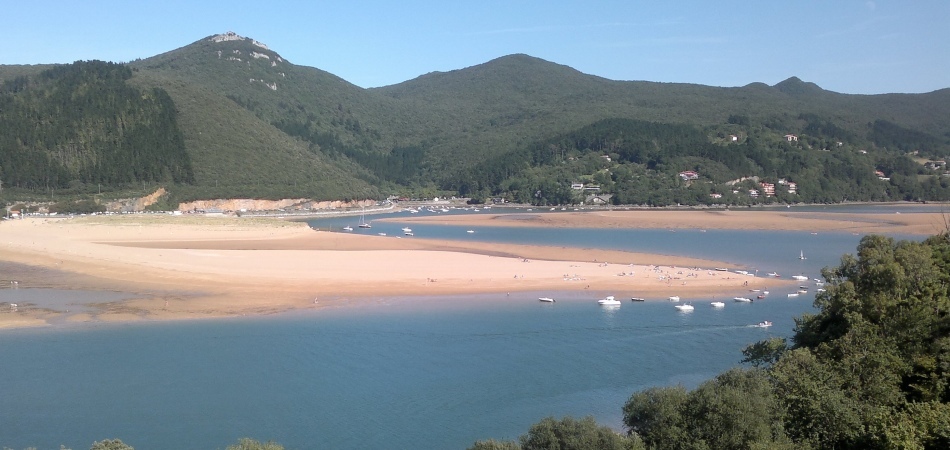 Ria de Gernika
Ria de Gernika - A few more small towns,whose beaches can beattract your attention and will be interesting old streets to stroll: Leyketo( Leiketio), Sumaya( Sumaia), Getaria( Getaria)
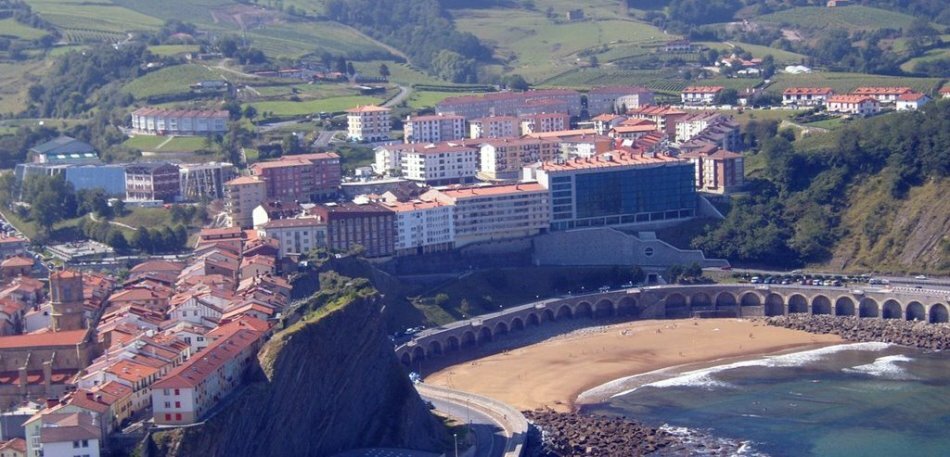 Beach Getaria( Getaria)
Beach Getaria( Getaria) Kitchen
Basque Country Basque cuisine is considered one of the finest in the world. It is characterized by the simplicity of recipes and the high quality of the products used in cooking. There are many restaurants, celebrated with Michelin stars, only in one San Sebastian with a population of no more than 300 thousand inhabitants of such restaurants four.
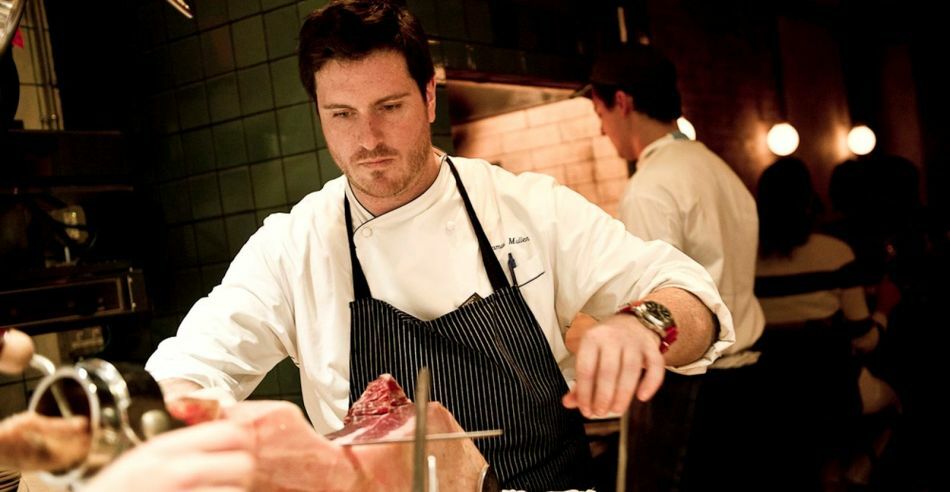
The most characteristic dishes of Baskonia:
- Marmitako - tuna soup with the addition of potatoes, tomatoes, garlic and spicy seasonings
- Idiazábal cheese is a cheese of solid sorts, in the preparation of which only raw sheep milk is used
- Pinchos( pintxos) is a slice of bread witha special tapas on the Mediterranean coast of Spain
- Chuleton de Vaca - beef steak with blood, cooked on the grill, with an abundance of spices
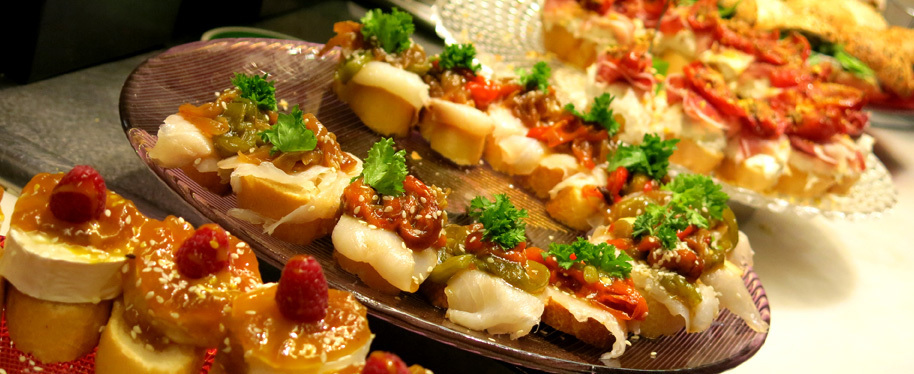 Pinchos( pintxos)
Pinchos( pintxos) - Chipirones( chipirones) - small squid andtoraccoon, often prepared in own ink
- Bakalo( bacalo) - various dishes from cod, cooked in a variety of ways: in sauce, with vegetables, dried on charcoal and other options
- Sukalki( sukalki) - meat stew with vegetables and seasonings
- Cuajada - dessert made of milk with honey and nuts
- Drinks are popular apple cider "sardargo", white dry wine "chakkoli", berry liqueurs "pacharan"
